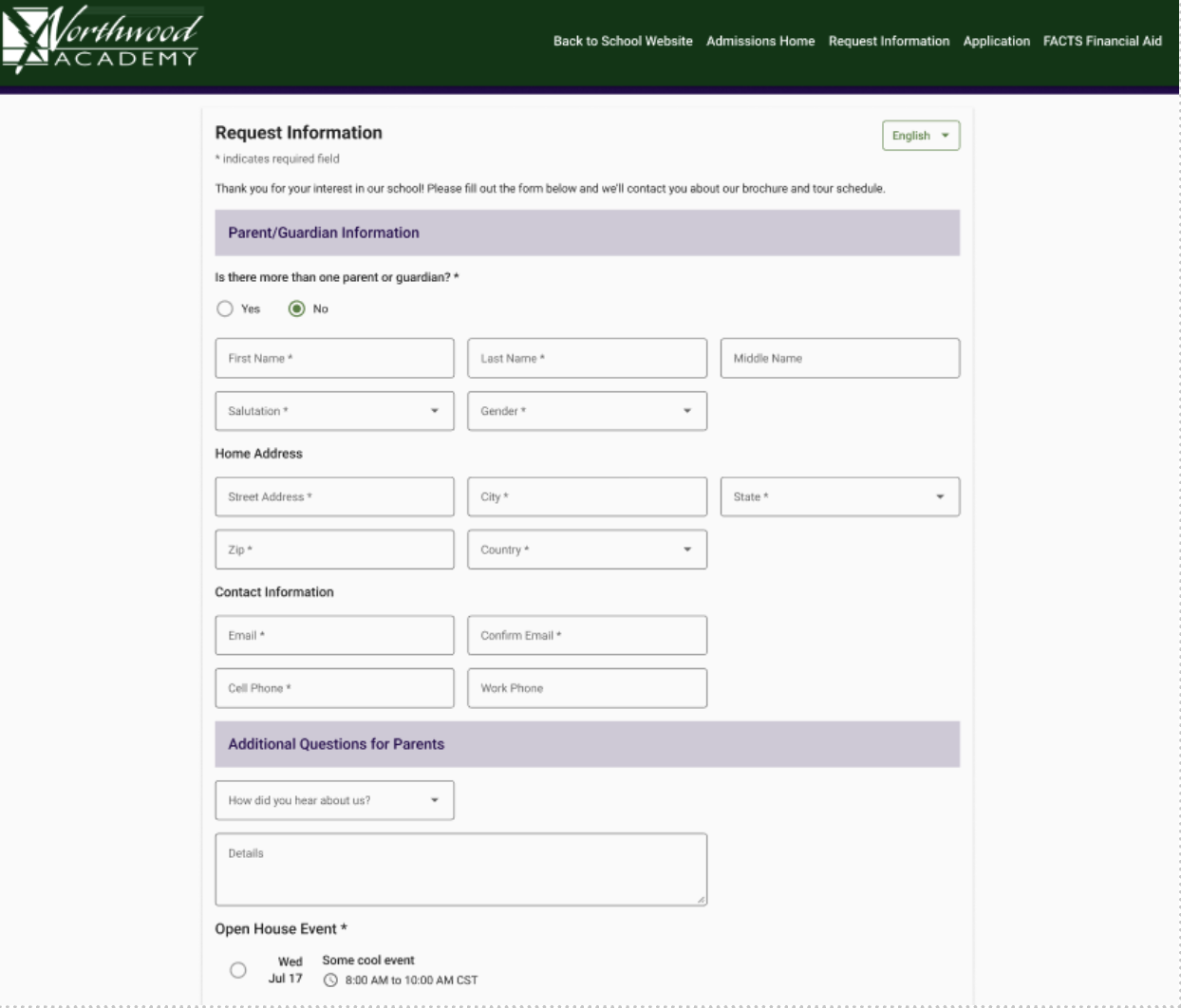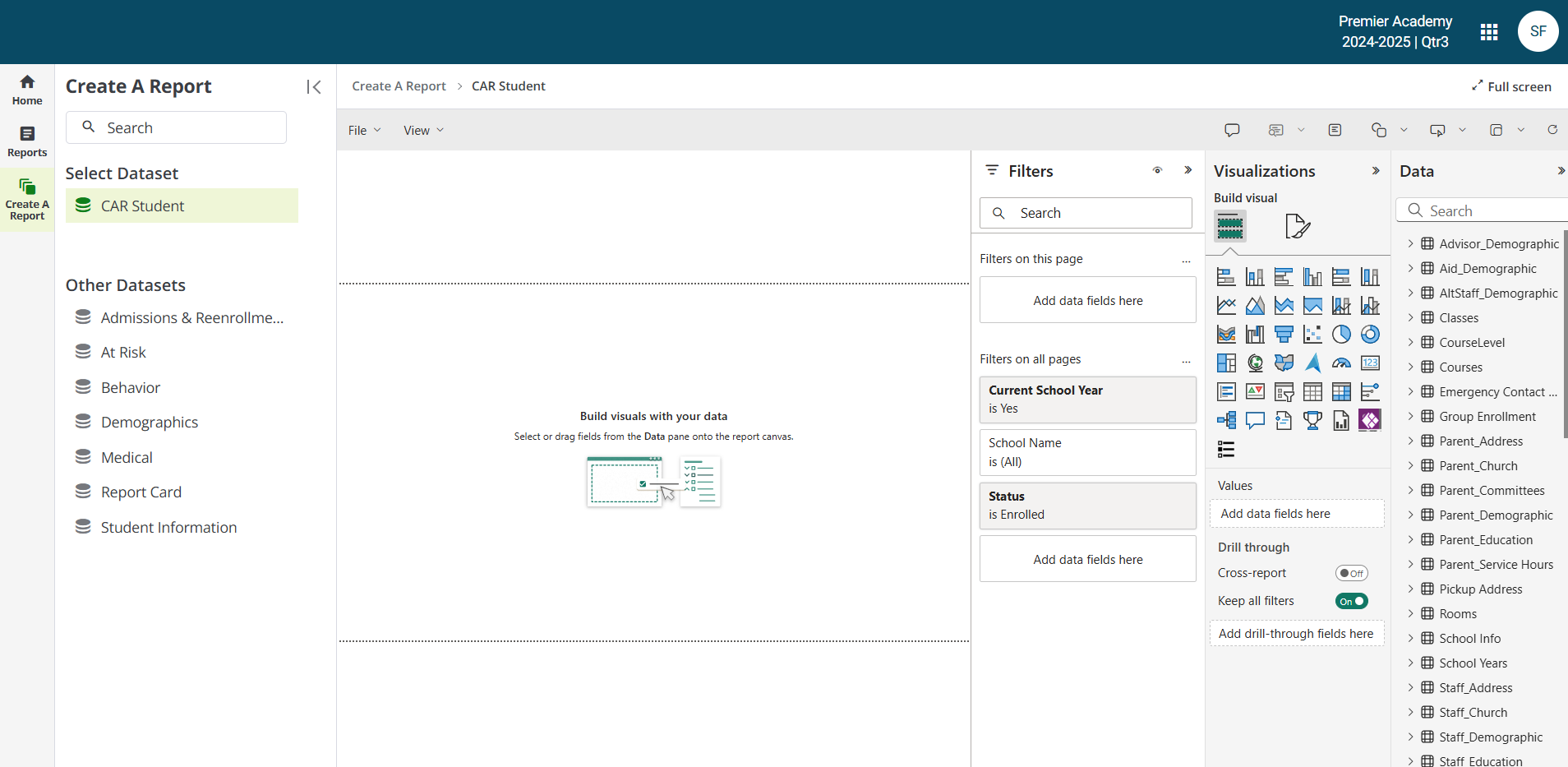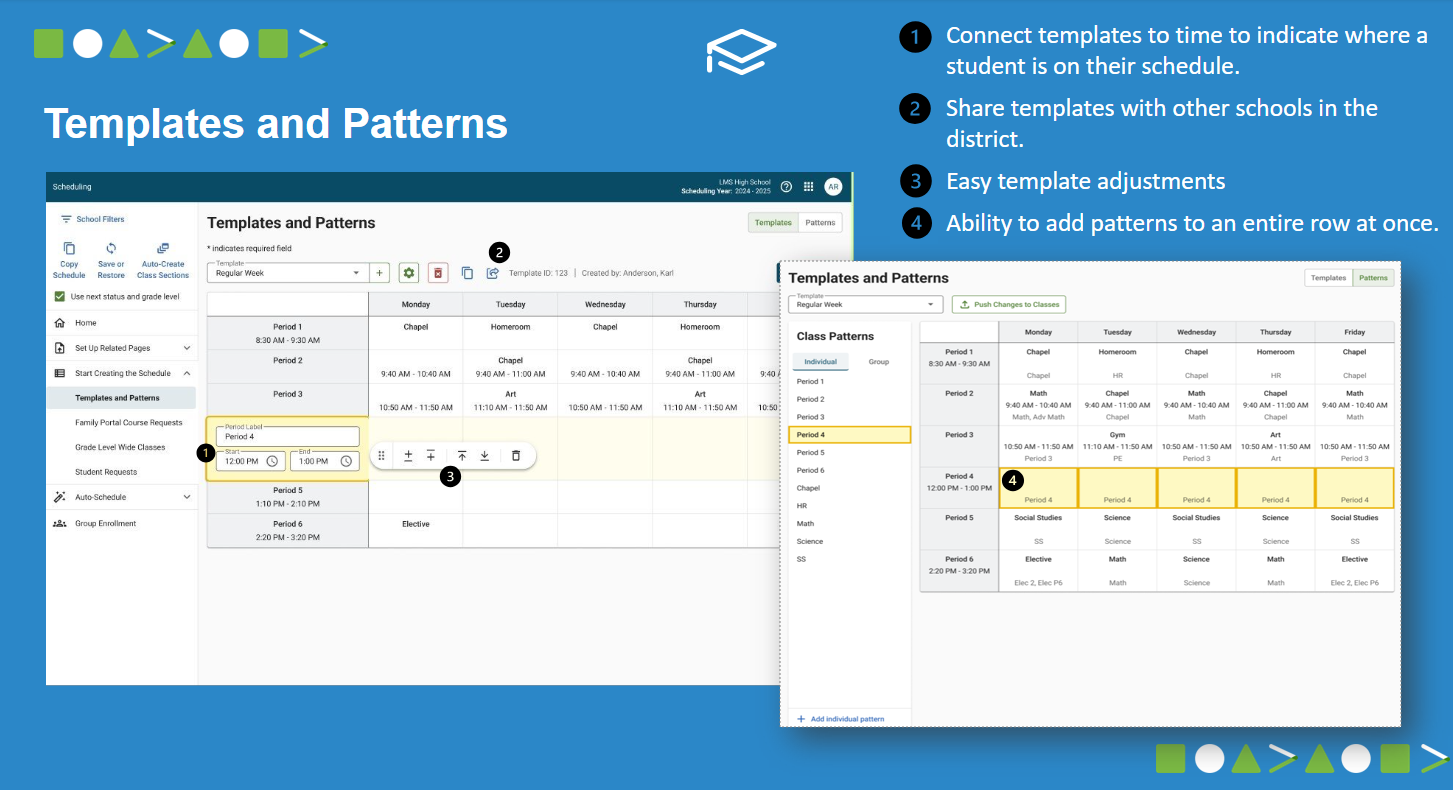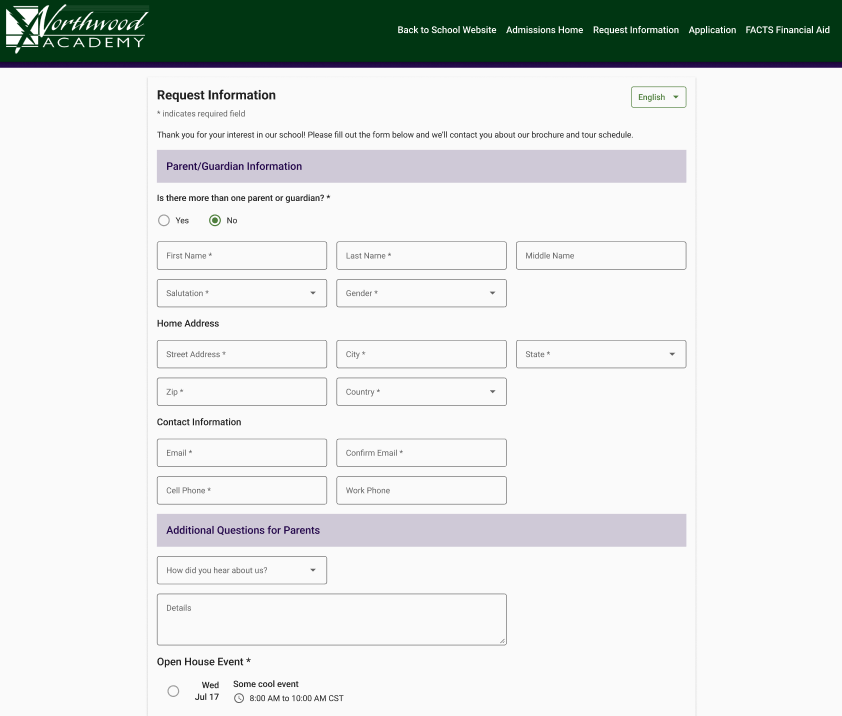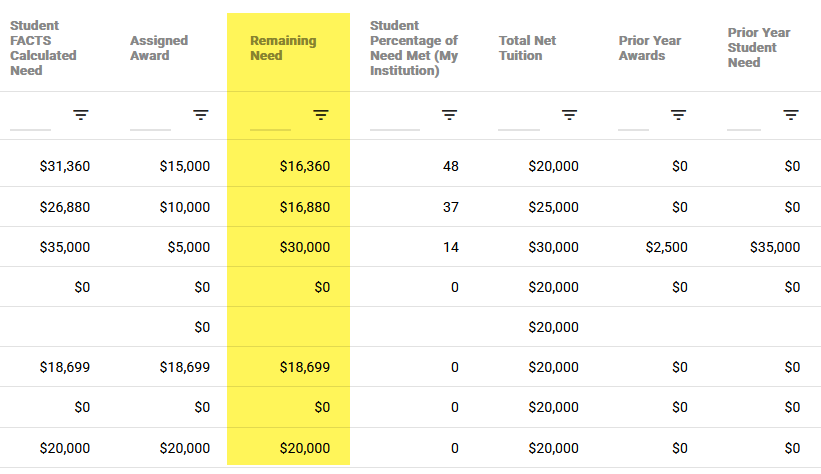- Products
-
-
Industries
- K-12 Schools
Whole-school solutions that meet your unique needs
- Faith Communities
Online faith formation and member engagement
Elevating Education
Contact Sales- K-12 Schools
-
- Products
- Industries
- Resources
- Company
- Parents
What’s New and Next at FACTS: Q2 Product Roadmap Update
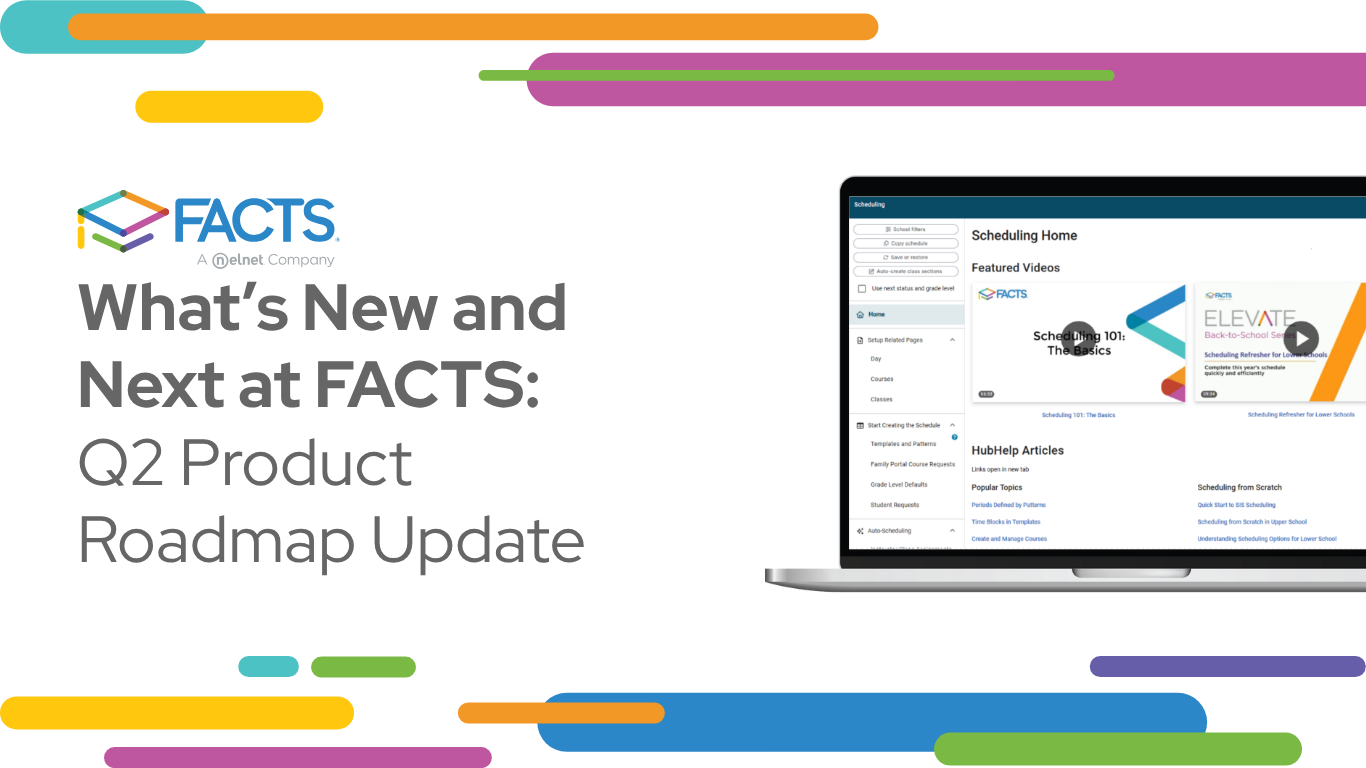
We’re back with the second installment of our quarterly product roadmap series! At FACTS, your feedback continues to guide how we build and improve our solutions, and we’re committed to keeping you in the loop every step of the way. In this update, you’ll get a look at what’s launched recently, what’s currently in progress, and what’s ahead across our product suite. Keep reading for your official Q2 update.
Product Updates:
Student Information System
What’s New with Student Information System
Scheduling:
We launched our first phase of scheduling enhancements on June 9. This release included an update to our general scheduling application, updates to templates and patterns, and our new person locator, which can be used to locate students and staff members according to their daily schedule.

Medical:
Released May 27, our medical enhancements include a brand-new interface along with many at-a-glance features to help school medical staff manage student health records. We also completed key school-requested updates, like removing the ability to overwrite medical notes and allowing staff to select relationship types before emailing parents about medical events.
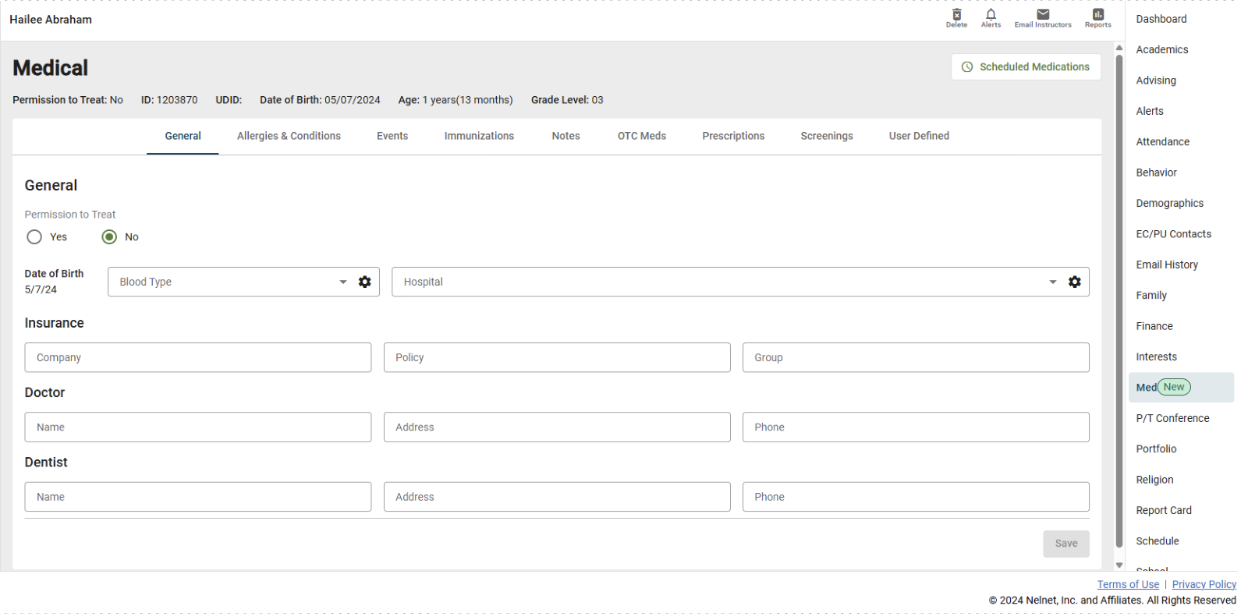
SIS Main Menu and Navigation Bar:
On June 9, we released our new SIS main menu and navigation bar that includes a more modern look with icons for menu items and better placement of help icons.
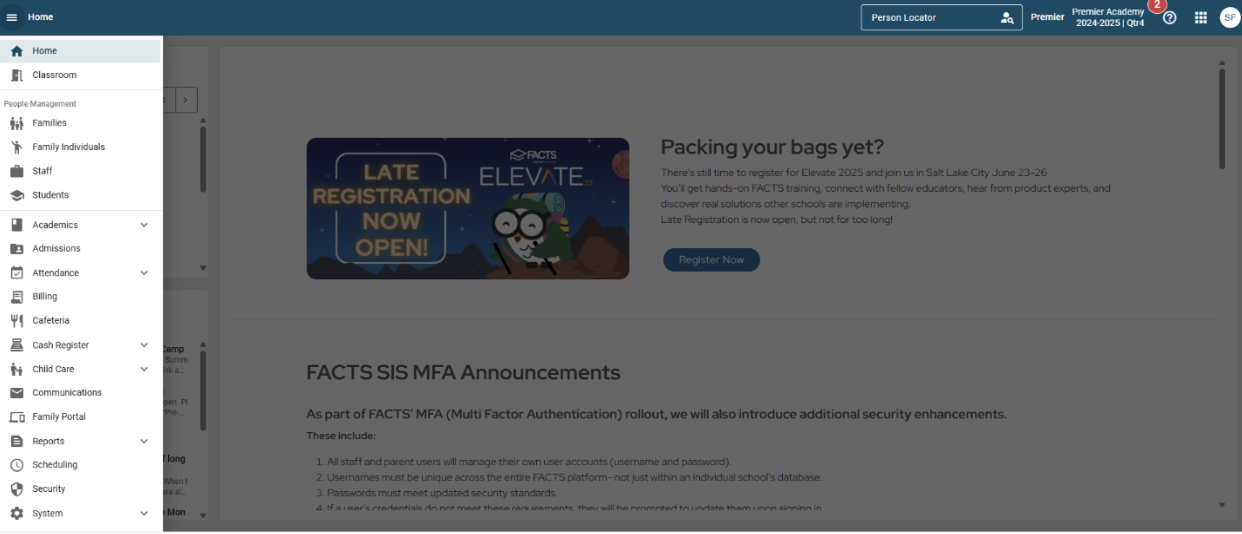
What’s Near with Student Information System
Dashboard Builder:
This is a Power BI embedded reporting solution designed for K-12 school users. It enables educators to create, customize, and share dashboards using live data from the SIS. Users will have access to pre-built dashboards such as Student Information, Medical, Behavior, Admissions, or At-Risk. Additionally, school users can export reports for use in meetings or compliance reviews. With Dashboard Builder, we are making data accessible for all users!
Multi-Factor Authentication (MFA):
We’re excited to share the latest progress on our rollout of Multi-Factor Authentication (MFA) for SIS users.
Since our last update:
- We completed beta testing with a group of schools using Premier Integration.
- We gathered feedback from a broader set of users across our SIS platform.
- Based on that feedback, we extended the authentication window from 4 hours to 8 hours, reducing the need for frequent re-authentication during the day.
What to Expect:
- Rollout Timeline: We are targeting to have all SIS schools enabled by the end of August.
- Advance Notice: Schools will receive at least two weeks’ notice before MFA is enabled. Notifications will come from your Account Manager and appear directly in the SIS via in-app messaging.
For more information on MFA and related changes, please visit: https://www.nbshubhelp.com/
What’s Next with Student Information System
Here’s a sneak peek at some things we’re exploring and building behind the scenes. These updates are on our roadmap, but they might take a little time—good things are worth the wait! Want to share your thoughts or stay in the loop in the meantime? Join the conversation in FACTS^SPACE.
Scheduling:
We continue to work on our large, comprehensive update to scheduling. This project will include an updated interface to make scheduling more intuitive for school staff, added features such as teacher recommendations and the ability to mass update classes, and improvements to reporting to help manage scheduling conflicts and ensure scheduling is complete. The project also includes enhancements to courses and classes that support the scheduling process. This is an ongoing initiative, with features released in phases.
- Phase 1 is now live, and here’s what’s coming next:
- Phase 2 – Course Requests
- Phase 3 – Courses, Classes, and Rooms
- Phase 4 – Manual and Auto Scheduling Enhancements
- Phase 5 – Updates to schedule reporting
Application & Enrollment
What’s New with Application & Enrollment
Multi-Factor Authentication (MFA):
Our Application & Enrollment teams released all changes needed to be ready for the MFA Launch happening next quarter!
What’s Near with Application & Enrollment
We’re introducing Inquiry Triggers to Email Series Manager, enabling you to automatically send nurturing emails to parents who submit an inquiry. This enhancement also includes an opt-out option for marketing emails, giving families greater control over the communications they receive.
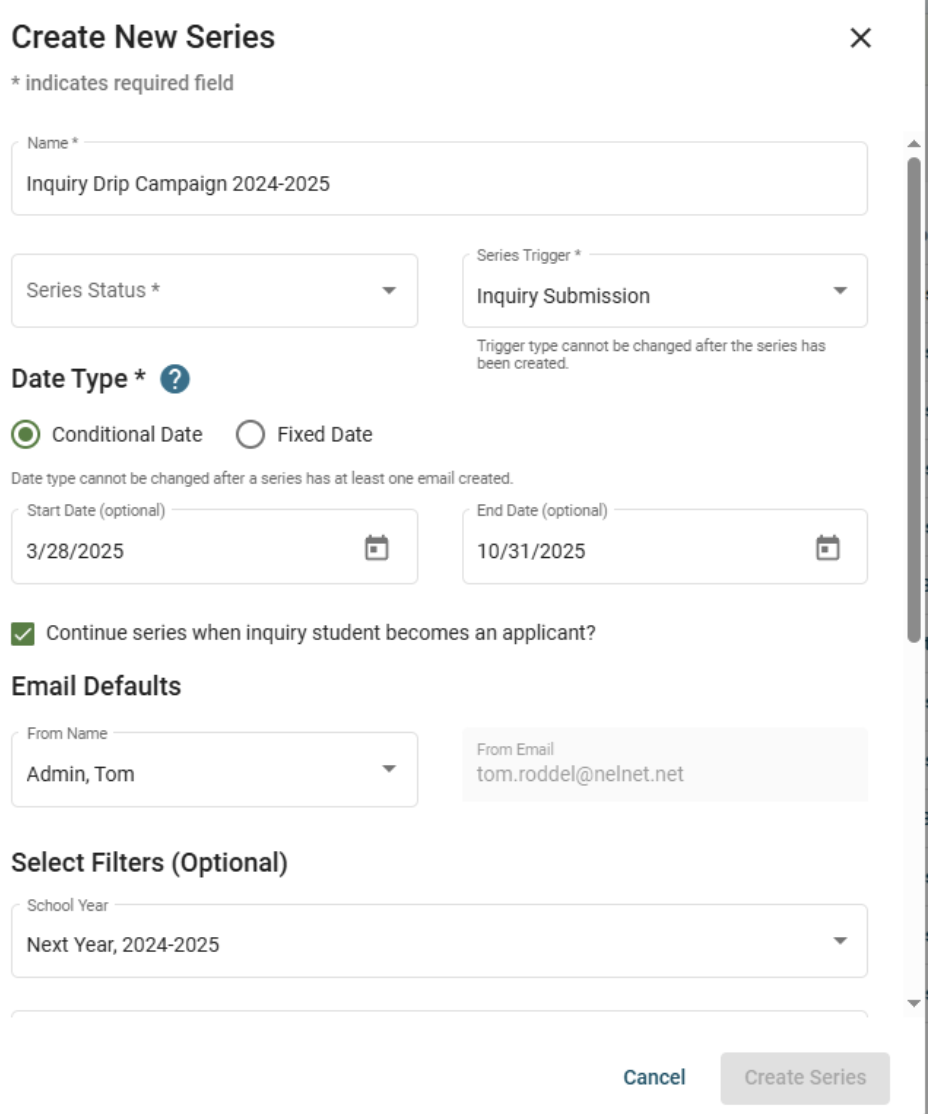
What’s Next with Application & Enrollment
New Look and Experience for Inquiry & Application:
We’re continuing to modernize the Parent Inquiry and Application experience! Over the next year, we’ll transform the look and feel of our platform to provide a more modern and visually appealing experience. But that’s not all: our focus is also on enhancing the user experience with improved, intuitive, and streamlined workflows, all built with a mobile-first design approach to ensure accessibility and ease of use across devices. Expect a smoother, more efficient process that will make your parents’ interaction with our system more enjoyable.
Grant & Aid Assessment
What’s New with Grant & Aid Assessment
SIS Current Student Status Integration:
Previously, we added the ability to show the SIS student admission status and new/returning status in Grant & Aid custom reporting. Now, you can also add the SIS current student status for an up-to-date status throughout the school year.
IRS Integration Updates:
We have added the ability for co-applicants who file separately to get their tax transcripts through IRS integration.
Supplemental Document Enhancements:
Supplemental documents allow you to collect extra documents outside of the FACTS collected and reviewed tax documents.
We added two enhancements to increase flexibility in triggering document requests, ensuring only relevant families see them as a requirement. You now can conditionally request documents based on:
- Family Not Filing Taxes (DNF Status): Request documents from families not filing taxes, such as an attestation of non-filing.
- Internal Tracking Fields selection: This allows you to tie a document requirement to a checkbox or drop-down option for internal tracking, allowing you to add document requirements after reviewing a family’s submitted application. You will be able to leverage all the tools associated with internal tracking, such as being able to assign documents in mass within reports.
New Fund Details Page:
As part of our ongoing modernization, we’ve updated the Fund Detail Awarding page with a refreshed design, full-screen viewing, faster reporting, and an improved user experience!
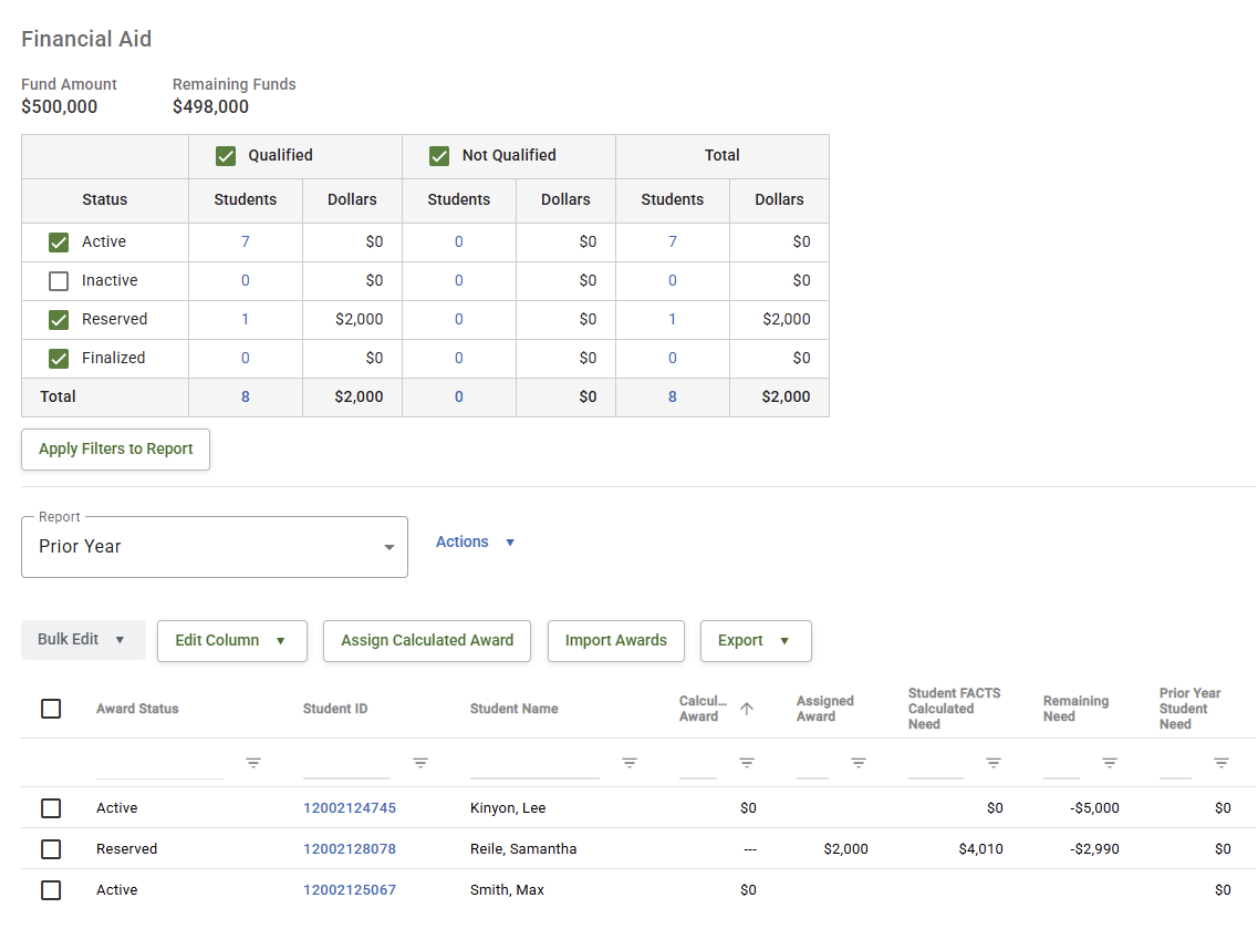
Student Submit Date/Timestamp as a Reporting Field:
To assist with scholarship organizations prioritizing by submission date and time, we’ve added a student specific submit date and time stamp reporting field that can be added to all custom reporting areas.
Preference School Change Notification:
Scholarship organizations will now get a notification in the Daily Digest when a student’s preference school changes.
What’s Near with Grant & Aid Assessment
IRS Integration:
- Most Recent Year Tax Return: We have added the ability to retrieve the most recent tax documents from the IRS. This will become available as soon as the IRS fixes an issue with the 2024 transcripts, which is scheduled to be released July 20.
- W2s: We will be adding the ability for applicants and co-applicants to get their W2s directly from the IRS in addition to the tax returns. This will include both the prior year and most recent year W2s as they become available through the IRS. We expect to release this on July 28.
Turn Off W2 Wage Adjustment & New Year Document Override:
Currently, our system automatically adjusts a family’s income based on the most recent W2 when paired with a prior year tax return and will use the most recent tax return when submitted by a family.
Some of our schools and scholarship organizations have requested the ability to turn off this automatic adjustment, allowing them to receive more recent year’s W2 without it affecting the family’s assessment, or still request and use the prior year tax return in the assessment even when the most recent year has been received. This will be an optional setting.
What’s Next with Grant & Aid Assessment
Prefill Custom Questions for Returning Users:
To continue to make the applicant process easier for returning families, we are adding the ability to select if the responses to a custom question should be pre-filled based on last year’s responses. This can be chosen per custom question, and applicants will still have the ability to update the response if something has changed from last year.
Payment Plans & Billing
What’s New with Payment Plans & Billing
3rd Party Payment at Institution:
We’ve added the ability to record a Payment at Institution from a third party, such as payments from school choice programs. This will give you better reporting on the money received from school choice programs and ensure the parents’ payment summary is accurate, as it will not include these payments.
What’s Near with Payment Plans & Billing
3rd Party Payment at Institution Phase 2:
Following the initial release of this enhancement, we received valuable feedback that highlighted opportunities for greater flexibility. As a result, we will be adding support for multiple editable third-party adjustment reasons.
What’s Next with Payment Plans & Billing
Auto-Replenish Prepay Accounts:
We will be working on adding the ability for families to have their Prepay Account automatically refreshed from a saved account when the balance reaches a certain threshold. Love this idea and want the most up-to-date news? “Like” the idea in FACTS^SPACE and you’ll be among the first to know!
Mass Transfer of Funds & Credits:
We are excited to announce that we will soon be adding the capability to transfer funds and credits in mass. Previously, we introduced this feature for balances due and received valuable feedback indicating a need for similar functionality for funds and credits.
Parent Invoices for School Choice Programs:
To meet state requirements, we aim to provide parents with compliant documentation that supports state-level funding processes. This ensures regulatory adherence while simplifying the experience for families.
Payment Plan Modernization:
Modernizing the payment plan enrollment experience enables parents to sign up for a payment plan from any device, streamlining and simplifying the enrollment steps, and enhancing existing processes. The updated experience will include compliant disclosures and leverage a design system to ensure a modern, accessible, and user-friendly interface.
Thanks for reading! We’re continuing to build and improve with your needs in mind, and we can’t wait to share more. Stay tuned for our Q3 update!
In today’s educational landscape, extracurricular activities have expanded far beyond traditional sports. From robotics and debate to drama and environmental clubs, students are engaging in a diverse array of programs that enrich their academic experience and build lifelong skills.
According to the U.S. Census Bureau, 57% of children aged 6 to 17 participate in at least one after-school extracurricular activity, and nearly 29% are involved in clubs or non-sport lessons such as music, language, or drama. These programs aren’t just feel-good add-ons—they’re game-changers for student development, building confidence, commitment, and community.
Despite their importance, many of these programs lack access to custom apparel that fosters unity and school spirit. Gary Goldberg, President and Founder of SquadLocker, emphasizes,
“Every student group, whether it’s the chess club or the marching band, deserves the same sense of identity and pride that a football team enjoys. Our mission is to ensure that all programs have access to high-quality, custom apparel that brings their members together.”
Inclusivity Through Innovation
SquadLocker’s made-to-order, single-unit manufacturing model eliminates order minimums and keeps online stores open year-round. That means even the smallest clubs can outfit their members without financial strain or logistical headaches.
“Unlike other platforms I’ve worked with, SquadLocker is built for inclusivity,” says Matt McGovern, National Account Manager at SquadLocker. “A club with five students gets the same quality gear, service, and attention as a varsity team. Our SquadSchool program takes that even further, providing built-in fundraising, unlimited artwork services, and exclusive gear extras. It helps these programs stand out and raise the funds they need to keep investing in student development.”
Fundraising That Fuels School Spirit
Apparel isn’t just a utility—it’s a powerful fundraising tool. With SquadLocker’s built-in fundraising features, clubs and teams can earn money every time someone purchases spirit wear. No inventory. No hassle. Just seamless support.
This aligns perfectly with guidance from FACTS Management, who note that successful fundraisers should focus on three things:
- Ease of setup
- Low overhead
- High return
As FACTS says, “Fundraising isn’t only about collecting donations—it’s also a chance to boost morale and get your students, staff, and families full of school pride and the spirit of giving.”
With options like spirit wear stores, students, parents, and supporters can rally around a cause and represent their community in style. And when paired with FACTS Giving, schools can integrate tracking, automate giving, and even activate tools like text-to-give, making it even easier to support emerging programs—from STEM to multicultural initiatives.
A School-Wide Solution: SquadSchool
To support school-wide equity and organization, our SquadSchool membership program takes things a step further. Schools enrolled in SquadSchool receive:
- Professional artwork services for high-quality, branded designs.
- A custom landing page featuring all school clubs, teams, and activities.
- A single shopping cart experience for families to easily purchase gear across multiple programs.
It’s a scalable solution that reduces friction and elevates visibility for every group, not just the big names on campus.
Built to Partner: FACTS + SquadLocker
Our integration with FACTS Management connects custom apparel to a broader school ecosystem that includes tuition management, communication tools, family engagement, and more.
With SquadLocker as part of that whole-school platform, custom gear becomes another seamless touchpoint—streamlined, secure, and fully aligned with how modern schools operate.
Read the full press release about the FACTS x SquadLocker partnership
Supporting All Students, All Year Long
Whether it’s an emerging pickleball team, a growing esports league, or a small STEM club just getting started, every student deserves to feel seen, united, and proud. At SquadLocker, we make it possible—with no order minimums, 24/7 stores, inclusive design tools, and built-in fundraising that fuels what’s next.
Learn more about how SquadLocker and SquadSchool can support your school’s diverse programs.
Safety is a cornerstone of every school. It’s not just a regulatory concern—it’s a reflection of stewardship, trust, and care for students. As schools serve growing communities of students, families, and staff, the need for a dependable, modern visitor management system (VMS) becomes not just relevant—but essential.
Gone are the days when a handwritten name on a sign-in sheet was enough. In today’s environment, schools need smart, efficient tools that provide real-time visibility, accountability, and security for every person entering campus grounds.
Let’s explore why schools are increasingly adopting VMS as part of their commitment to protecting what matters most.
What Is a Visitor Management System (VMS)?
A Visitor Management System is a digital upgrade to traditional sign-in processes. It replaces pen-and-paper logs with a secure system that scans IDs, tracks visitor movement, and stores visit records.
For schools, this means:
- Knowing exactly who is on campus at any time
- Ensuring all visitors are properly identified
- Logging visit history for security and compliance purposes
- Preventing unauthorized access to school facilities
Why It Matters for Education
Private and independent schools are known for their close-knit communities. Parents, church staff, volunteers, and vendors regularly walk through campus doors. This makes it even more important to ensure that everyone who enters is identified, logged, and cleared.
A VMS does more than log names—it supports a school’s commitment to safety, order, and accountability, all while honoring the values that guide its mission.
Benefits of a VMS for Schools
1. Real-Time Awareness and Accountability
A visitor management system ensures that school leaders always know who is on campus. Whether it’s a parent, a repair technician, or a guest speaker, the system tracks check-in and check-out times with precision. This visibility is vital not only for everyday operations but also during emergency situations, reunifications, or lockdowns.
2. Faster, Smoother Check-Ins
Busy mornings and events can create congestion at the front office. A VMS streamlines this process with:
- ID Scanning: Captures visitor data securely
- On-Demand Badge Printing: Clearly displays names, photos, and purposes of visit
- Pre-Registration: Speeds up check-ins for returning or scheduled guests
This creates a more organized, welcoming experience while reinforcing security protocols.
3. Built-In Safety Protocols
In schools, nurturing environments go hand-in-hand with strong protection. A VMS can instantly flag visitors who may pose a risk, based on background check integration. If an emergency arises, staff can access a full list of who is on-site within seconds—an invaluable feature for first responders.
VMS platforms can also integrate with school alert systems, ensuring coordinated responses during drills or real incidents.
Reassuring Families Through Transparency
Families seek schools they can trust. A visible, reliable visitor management process reinforces that trust.
- Parents see a professional, consistent approach to safety
- Visitors experience a streamlined, respectful check-in process
- Staff have peace of mind knowing protocols are followed without exception
This builds a culture of openness, responsibility, and shared commitment to protecting students.
Integrating VMS with Other Safety Tools
Visitor management works best when paired with broader campus safety strategies. Many FACTS partner schools combine VMS with:
- Access Control Systems: Limit entry to authorized personnel
- Security Cameras: Log visits with time-stamped video for added verification
- Emergency Management Tools: Support reunification and lockdown protocols
Together, these tools create a comprehensive safety system.
Compliance, Documentation, and Stewardship
School administrators must often balance limited resources with high expectations. A VMS helps schools remain compliant with state safety laws and accreditation standards by:
- Maintaining digital visitor logs for audits
- Supporting emergency drills with attendance data
- Reducing manual recordkeeping, saving valuable staff time
It’s an investment in stewardship—protecting both people and processes.
Challenges to Consider
As with any new system, there are considerations:
- Cost: Schools must budget for hardware, software, and training
- Training: Staff need clear onboarding to use the system effectively
- Data Privacy: Visitor data must be handled securely, in compliance with laws
However, the long-term benefits in safety, trust, and operational efficiency far outweigh the initial lift. VMS providers like Pikmykid, who serve faith based and independent schools, offer scalable, user-friendly options to support smooth implementation.
A Smart, Values-Aligned Decision
Adopting a VMS isn’t just about technology—it’s about reinforcing the values of diligence, care, and responsibility that define education.
It tells families: “We’re watching. We’re ready. We’re committed to keeping your children safe—not just in prayer, but in practice.”
As school safety concerns grow, the need for tools like VMS grows with them. Schools must continue to evaluate their processes and strengthen their safety posture in a way that reflects their goals or mission.
Take the Next Step
If your school is exploring ways to improve campus security, strengthen emergency readiness, and build trust with your families, a VMS may be the right solution.
Learn how visitor management fits into your school’s safety strategy with a free consultation with Pikmykid.
Private school fees have been in the spotlight recently. According to the Australian Financial Review, tuition costs at most independent schools will rise far beyond inflation in 2025 — an average increase of nearly 6%.
In an environment where cost-of-living pressures have placed many families under financial pressure, rising school fees are a high-profile and emotive topic. Given this, it’s critical that schools are transparent in communicating why fees are increasing so sharply and giving families confidence about how their contributions are being spent.
1. Builds trust and credibility
Families want transparency about school fee structures, particularly in tough economic times. While independent schools may not be obliged to share details regarding their tuition decisions with stakeholders, providing families with some context about significant rises is invaluable in fostering trust. By being open about changes to fees – without delving into the micro details – schools can make it clear that they respect their community and view their relationships with families as partnerships rather than that of service providers and customers.
2. Attracts new enrolments
School fees are undoubtedly one of the major considerations for prospective parents assessing different schooling options for their child. In the case of K-12 schools, deciding to enrol at a particular school is the start of a relationship that will usually last for more than a decade. A transparent fee structure and having tuition information freely available via channels like the school’s website provides a strong first impression and reinforces your school’s brand as transparent and trustworthy.
3. Helps families manage their finances
School fee clarity helps families to plan and budget effectively and reduces the stress associated with unexpected costs. By providing families with a clear view of all fees due throughout a school year and giving them flexibility in how they make payments, schools can show their commitment to supporting their community. Specialist tuition payment solutions like FACTS Tuition Management give families payment flexibility within parameters set by the school, making it easy for them to manage their fees in a way that suits them while still meeting your school’s payment expectations.
4. Supports regulatory and reporting requirements
Australian independent schools operate as not-for-profit organisations and, as such, are subject to robust accountability and reporting requirements. Their registrations with state and territory authorities are regularly reviewed, including ensuring compliance with educational standards and financial accountability requirements. This makes it crucial for schools to maintain transparent, up-to-date records of their tuition fee structures and financial transactions. Beyond legal obligations, schools that embrace transparency around fees foster a culture where integrity and operating fairly and ethically are valued.
Being clear and upfront about fees is a simple and effective way for schools to build trust with families. Education is a deeply personal and long-term relationship between student, family and school, so cultivating trusted partnerships in a collaborative environment is a must. A tuition fee structure and process where families feel respected, informed, and in control will build your school’s brand and reputation as an institution of choice.
More than 11,500 schools worldwide trust FACTS Tuition Management to help them embed a best-practice approach to tuition fees. Get in touch for more information about our leading tuition management platform.
As school choice expands at the state level, new momentum is building at the federal level through the Educational Choice for Children Act (ECCA). This proposed tax credit program could unlock up to $5 billion annually in private donations to fund K-12 scholarships.
The ECCA has gained significant traction and was recently included in the U.S. House’s budget reconciliation process, though it is not yet a law. The most recent version of the bill restores important protections for religious liberty, an issue closely watched by private schools and scholarship organizations.
What’s the ECCA?
The ECCA is designed to make private education more accessible to families by providing federal tax credits to individuals and businesses that donate to Scholarship Granting Organizations (SGOs). These SGOs then provide scholarships to eligible students for tuition and other educational expenses at participating private schools. As federal lawmakers debate the future of school choice, the ECCA could represent the most significant national expansion to date.
The ECCA is a federal initiative that would create up to $5 billion annually in tax credits for donations to SGOs. In turn, these organizations fund scholarships for K–12 students to attend private schools across the country, including faith-based schools. The program aims to complement existing state-based school choice programs and address the rising demand for educational alternatives.
Here are the core elements of the program:
- Annual Volume Cap: $5 billion in federal tax credits, available from 2026 through 2029.
- Donor Eligibility: Only individual income taxpayers may participate. Corporate donors are not eligible.
- Donation Limit: Up to 10% of adjusted gross income (AGI) or $5,000, whichever is greater.
- Student Eligibility: Must be eligible to attend public school and have a household income at or below 300% of Area Median Income (AMI).
- Qualified Expenses: Tuition, fees, educational materials, therapies, dual enrollment, tutoring, and more.
- State Set-Aside: 10% of the annual volume cap is allocated evenly across all 50 states and reserved for residents of those states.
- First-Come, First-Serve Allocation: Credits are awarded in the order contributions are received, with no allocations after December 31 of each year.
- Sunset Clause: The program is authorized through 2029 and would require reauthorization to continue beyond that.
What’s Changed in the Latest Draft?
The most recent draft of the ECCA restores specific language that protects the religious liberty of participating schools. This ensures that faith-based schools can continue to operate according to their religious mission and beliefs while participating in the program. The addition of this language addresses concerns from religious organizations and school leaders who advocated for clear protections. Additional adjustments include:
- Reduced funding cap from $10B to $5B annually
- Program is now time-limited: 2026–2029
- Corporate donors removed
- Scholarships are currently treated as taxable income (expected to be fixed)
- New admission mandate for special education students was added (also expected to be challenged)
What It Means for SGOs and Schools
This legislation presents a new funding stream that could significantly expand access to private education. However, it also brings operational expectations:
- SGOs must verify income, distribute funds on a timeline, and manage audits.
- Schools may need to review admission policies to ensure eligibility.
- Donors may ask new questions about tax credits, including state versus federal programs and their impact.
For SGOs and private schools, the restoration of religious liberty protections is significant. It means faith-based organizations can confidently participate in the ECCA without compromising their values or operational autonomy. At the same time, the enhanced federal tax credit could dramatically increase the pool of available scholarship funds, expanding access for more families.
Being ready early means being positioned to grow.
How FACTS Is Preparing
SGOs need to know they’re working with a trusted leader in school choice and scholarship management. FACTS is actively monitoring developments in the ECCA legislation and preparing solutions to support schools and SGOs. We’re actively monitoring the ECCA’s progress and working to:
- Ensure our platforms are ready for federal compliance
- Educate clients with summaries, webinars, and FAQs
- Provide guidance on eligibility, documentation, and distribution requirements
Our eligibility verification and program management tools are designed to help organizations navigate new compliance requirements, ensure accurate reporting, and maximize scholarship impact.
Whether you’re a long-time SGO partner or just getting started, our goal is to make your transition into any new federal program seamless.
Learn More at Our Webinar
Want to learn more about the ECCA and what it means for your organization? Register for our webinar where we’ll break down the latest developments, answer your questions, and discuss how FACTS can help you navigate these changes. If you’d like to discuss how your organization can prepare for the ECCA, reach out to your FACTS representative or contact us directly.
As federal and state scholarship landscapes evolve, FACTS is here to help you adapt and thrive every step of the way.
Frequently Asked Questions
Q: Can donors claim both state and federal tax credits?
A: Yes. If donations are made to separate programs, donors may be eligible for both.
Q: Are scholarships really taxable?
A: The current draft says yes, but it is widely expected this will be corrected in a future revision.
Q: Will schools be required to change their admissions policies?
A: Possibly, depending on how the special education requirement survives reconciliation.
Q: Who qualifies as a donor?
A: Only individual taxpayers, not businesses or corporations.
Q: What if my SGO already participates in a state tax-credit program?
A: You may qualify under a “grandfathering” clause or meet the new federal criteria. More guidance will come as the bill progresses.
This information is for general guidance only and should not be considered legal or tax advice. For specific compliance questions, please consult with your legal or tax advisor.
When you’re looking for a restaurant, a doctor, or even the best local coffee shop, where’s the first place you turn? For most of us, it’s Google, and it’s no different for prospective families considering your school. Before they fill out an inquiry form or schedule a tour, many will do a quick search to get a first impression of your school, including reading Google reviews.
This blog kicks off a short series on increasing your school’s digital presence in today’s shifting online landscape. Over the coming weeks, we’ll share quick, actionable tips on everything from boosting your organic SEO to optimizing your school website and using FACTS’ tools to uncover and promote what makes your school stand out.
Big Changes
Recently, there’s been an important update that schools need to know: Google is removing some reviews for certain types of schools. While the full reasoning hasn’t been made public, it appears to relate to a policy shift where Google is restricting reviews for organizations considered public services or government-related, including many K–12 schools.
What to Do Next
If your school has relied on Google reviews as part of your marketing or SEO strategy, you might notice a sudden drop in the number of reviews or even see them disappear altogether. Here’s what you can do right now:
- Monitor your listing: Check your Google Business Profile regularly so you’re aware of any changes.
- Focus on other review platforms: Encourage families to leave testimonials on platforms like Niche, Private School Review, Facebook, or your own website. This could be a great time to consider incentivizing these reviews with gift cards, school merchandise, or more.
- Gather direct testimonials: Collect quotes, stories, and feedback from families that you can share in marketing materials, newsletters, and online. Re-enrollment is a good time to solicit these testimonials – you can add a quick testimonial box to your re-enrollment packet! If you don’t have a dedicated space for reviews on your website, consider adding them on your homepage for perspective parents to see the value of your school.
- Strengthen your owned channels: Make sure your website clearly communicates your value with proof points, highlights your community, and shares authentic stories since it may now be an even bigger first impression than your Google listing. Examples of good proof points include how many students are enrolled, your graduation rate, your classroom size ratios, how many STEM/STEAM classes or extracurricular activities are offered, what types of clubs are available, any sports or arts activities, awards you’ve earned, and parent testimonials.
This is also a great opportunity to take a closer look at the overall marketing strategy for your school. What is and isn’t working? Just as lessons plans change or school procedures change, marketing tactics should be looked at year over year to evaluate what changes need to be made.
Don’t Forget About the Power of Good Feedback
The purpose of reviews is to show your families’ feedback, helping potential families choose their next school knowledgeably and confidently. Here are a few simple questions you can ask families to help guide their feedback and highlight what makes your school special:
- What made you choose our school, and how has that decision impacted your family?
- Is there a teacher, program, or activity that has made a meaningful difference for your child?
- Can you share a moment or experience that made you feel confident your child is in the right place?
- What would you tell another parent who is considering enrolling their child here?
- While most feedback is good feedback, helping your families make reviews that answer questions and give the best possible insight into your school as possible is key.
The Bottom Line
Marketing your school is already a big task and staying on top of changes like this can feel overwhelming, especially if marketing isn’t your full-time job at the school. With a proactive strategy, you can continue to make strong, positive impressions on prospective families, even with fewer Google reviews to rely on. While they represent one approach to SEO, there are many others you can incorporate to attract perspective families to your school.
Stay in the loop by creating a Google alert (or multiple alerts) for keywords like “school marketing,” follow school marketing experts on LinkedIn to help you stay in the know, or follow us! We can’t wait to share more of these tips with you in this Smart Strategies series!
Want to learn more? Explore our blog for more insights, tips, and strategies on all things education.
We love hearing from users about how FACTS Student Information System (SIS) has helped them save time, improve communication, and stay focused on what matters most at their schools. One of the most frequent comments we get from school leaders, however, is how they’re constantly learning new things about what the SIS can do.
While it’s great to hear that people are continuing to find new ways to refine processes and save time, we want to make sure our schools are making the most out of FACTS SIS. One of the greatest tools for working smarter instead of harder? Maintenance Manager, a hidden gem included in FACTS SIS.
What is Maintenance Manager?
Maintenance Manager is a built-in automation tool that keeps your school running smoothly behind the scenes by allowing you to set up customized email alerts based on activity in your SIS. It makes it simple to stay on top of important student data and alert the right people at the right time without adding to your team’s workload. Say goodbye to having to dig for information to keep your staff and families informed!
Set It and Forget It
If you haven’t explored this feature yet, now’s the time. Here’s a quick overview of some of the top automated alerts you can set up in Maintenance Manager:
- Attendance Notifications: Automatically alert parents or staff when a student reaches a certain number of absences. This is an easy and effective way to support early intervention.
- Behavior Updates: Send automated messages based on the demerits or merits entered into your SIS, ensuring that behavior concerns or praise don’t go unnoticed.
- Missing Attendance Reminders: Automatically nudge teachers or admins if class attendance hasn’t been submitted. That means fewer data gaps, more complete records, and no more awkward reminder emails.
- Gradebook Alerts: Keep families informed by alerting them to missing, failing, or incomplete grades as soon as they’re entered. No surprises at report card time!
No Extra Work. Just Smarter Work.
Maintenance Manager is only one example of how the team here at FACTS is constantly improving our products based on feedback from schools and their real, day-to-day needs. The best part? You don’t need additional logins or training to start using this product; it’s already included in the SIS and just waiting for you to get started!
To learn more about Maintenance Manager, visit HubHelp for a quick training overview or to learn more about setting up reports. You can also check out our latest Product Roadmap Blog to learn more about FACTS product updates.
We’re excited to announce that Enquiry Tracker is the preferred, endorsed
enrolment solution for FACTS School Management. This extended integration
gives schools a more streamlined way to manage the enrolment journey—from
the initial enquiry through to student onboarding. Key data collected in Enquiry
Tracker flows directly into FACTS School Management, reducing manual data
entry, saving time, and improving accuracy. Together, FACTS and Enquiry
Tracker are helping schools simplify administrative processes and build a
connected school ecosystem that supports staff, caregivers, and students every
step of the way.
Enquiry Tracker helps schools collect the right information at the right time,
enabling them to build relationships with prospective families throughout the
enrolment process and grow enrolments.
“Enquiry Tracker integrates with FACTS School Management to make it easy for
schools to manage enrolments digitally via a sophisticated and easy-to-use CRM.
From capturing data at the initial enquiry stage to managing school tours and
open days, automating communication, and providing powerful analytics, Enquiry
Tracker delivers a modern experience for the school business office and families,”
said Simon Shenton, Head of Sales & Partnerships at FACTS.
Today, more than 550 schools globally trust Enquiry Tracker to help them gather
leads, nurture prospects via personalised workflows, and monitor their enrolment
pipeline in real time.
“We know many schools often use multiple systems to manage enrolments—
including spreadsheets that require data to be manually entered into the school
management system. Without a clear and consistent approach, staying on top of
enrolment documents – some submitted in person, some online, some via email,
and often from multiple email addresses —can be time-consuming and
inconsistent,” said Greg Campitelli, Director & Co-Founder at Enquiry Tracker.
“Enquiry Tracker has been designed and built by educational specialists
specifically to solve these common enrolment challenges,” added Greg.
“FACTS is committed to partnering with organisations that share our vision to
elevate the education experience for schools and their communities. We’re
excited to collaborate with Enquiry Tracker to offer schools a best-practice
enrolment experience,” said Mr Shenton.
We believe the best ideas come from listening to our customers. Your feedback has been instrumental in shaping our products, which is why we’re so excited to keep you informed with our new quarterly product roadmap updates. We’re looking forward to giving you a behind-the-scenes look at what’s new, what’s on the way, and what’s coming down the road across our product suite. Here’s your first update for 2025.
Product Updates:
Student Information System
What’s New with Student Information System
Security Updates:
We’ve added two new staff security permissions which allow for more nuanced data permissions.
- School List All – Allows the user to assign a staff member to any school in the district.
- School Information – Allows the user access to a staff member’s school information on the staff security screen.
Maiden Name:
Maiden name is now available in Family Individual Demographics and Staff Demographics.
What’s Near with Student Information System
MFA:
Multifactor Authentication (MFA) is currently available for all users accessing Tuition Management and Financial Aid, and we are in the process of rolling it out to SIS school and parent users. We expect MFA to be available for all SIS school and parent users by August!
There are a few changes that will occur as part of the update to add Multifactor Authentication to the SIS sign in process. Here’s what you need to know.
What’s Changing:
- MFA will be available as an option for staff and parents; however, students will not be prompted to use MFA.
- Users will have the option to enroll with email or an authenticator app.
- MFA will be optional, meaning users will have the ability to bypass setting it up and log in. We will continue to prompt the user every time they log in until they enroll.
Username/Password Management:
- Schools will no longer create or update usernames or passwords for staff or parents. Users will create and manage their own usernames and passwords.
- Schools will retain the ability to create usernames and passwords for student accounts that access the Family Portal.
- All users with an account will be required to have at least one email address, which must be entered in the “Email #1” field
- Usernames will need to be unique across all of FACTS. Today, usernames are unique to your specific school. If the existing username is not unique, the user will be prompted to update it the next time they login.
- Password requirements will be streamlined across all FACTS products and will no longer have an expiration date.
Dashboard Builder:
Currently in beta, the new dashboard builder allows you to create custom PowerBI dashboards. Schools may also enjoy selecting from various data options to create their own report. Using filter options, schools can drill down their data to get exactly what they need! We plan to have a full release of the new dashboard builder in Q2 2025.
We’re always listening, learning, and improving—and it’s all because of you. Your feedback continues to guide our work, and we’re excited to keep sharing updates as we roll out new features. Stay tuned for more to come!
What’s Next with Student Information System
Here’s a sneak peek at some things we’re exploring and building behind the scenes. These updates are on our roadmap, but they might take a little time—good things are worth the wait! Want to share your thoughts or stay in the loop in the meantime? Join the conversation in FACTS^SPACE.
Scheduling:
We are doing a large comprehensive update to scheduling that will be a theme over the next year. This project will include an updated interface to make scheduling more intuitive for school staff, added features such as teacher recommendations and the ability to mass update classes, and improvements to reporting to make it easier to manage scheduling conflicts and ensure your school scheduling is complete, along with other enhancements to courses and classes that make up a vital part of the school scheduling process. This will be an ongoing project, but we will be releasing features as they become available! We plan to roll this out in phases:
- Phase 1 – Templates and Patterns Configuration Enhancements
- Phase 2 – Course Requests
- Phase 3 – Courses, Classes, and Rooms
Here is a sneak peek at some of the plans for Templates and Patterns!
District Management Tool:
For our dioceses and districts, we’re creating a new system to help you better manage all your schools. Our first focus will be migrating the functionality from our current DART system with a few new improvements and will continue to update with more robust functionality over the next couple years. Reporting, security, configuration, district wide IDs, and more are heading your way!
Application & Enrollment
What's New with Application & Enrollment
Events Label Change:
Thank you for the large amount of feedback you gave us in FACTS^SPACE on this! We have changed the default label in events from “Not interested” to “Not at this time.”
What’s Near with Application & Enrollment
Inquiry Triggers for Email Series Manager: We will be adding Inquiry Triggers into our Email Series Manager that allow you to automate parent reach-out. This will include the option for parents to opt out of marketing emails, ensuring they have control over the communications they receive.
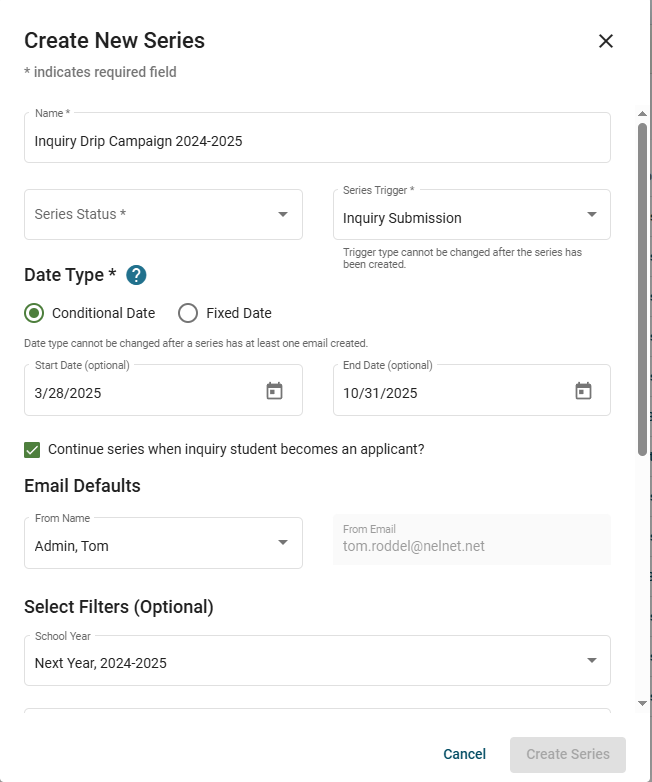
What’s Next with Application & Enrollment
New Look and Experience for Inquiry & Application:
We are modernizing the Inquiry and Application experience! Over the next year, we will be transforming the look and feel of our platform to provide a more modern and visually appealing experience. But that’s not all—our focus is also on enhancing the user experience with improved, intuitive, and streamlined workflows. Expect a smoother, more efficient process that will make your interactions with our system easier and more enjoyable.
Grant & Aid Assessment
What’s New with Grant & Aid Assessment
SIS Enrollment Status & New/Returning Status in Reporting:
You can now add the Application & Enrollment Status and the New/Returning status from the SIS directly into financial aid reports! Whether you want to see how a family is progressing through their admissions process or quickly identify returning new to aid families, that information is now at your fingertips.
IRS Integration:
With IRS Integration, applicants can now securely retrieve their tax transcripts directly from the IRS, eliminating the need to manually scan or upload financial documents. This not only streamlines the application process for families, but also reduces administrative work for schools and enhances data security. For more information, including a video and step by step brochure for families go to: https://factsmgt.com/grant-aid-assessment-irs-integration/
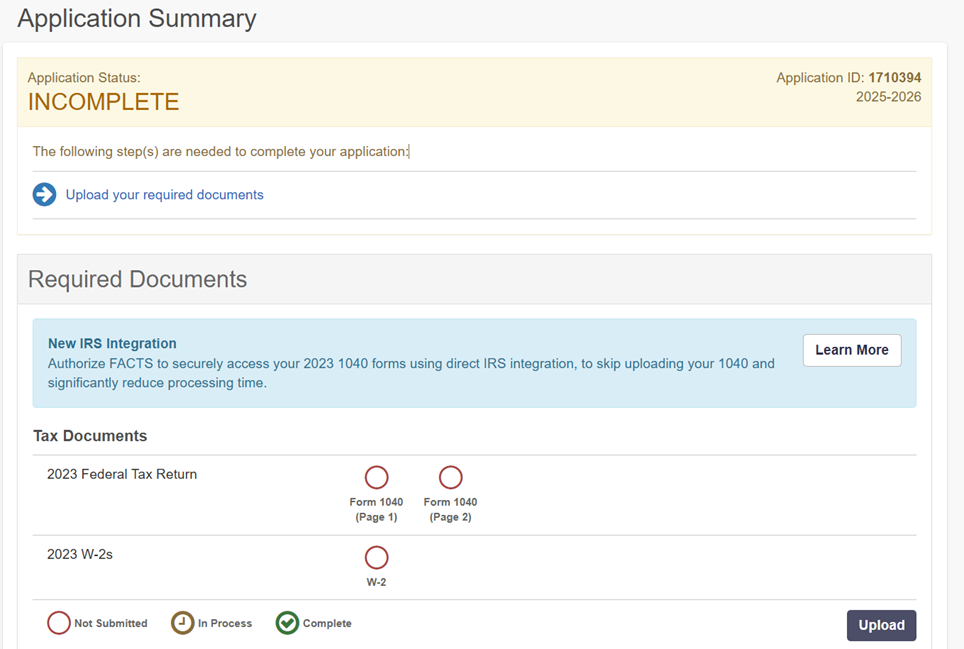
Student Level Internal Tracking Fields as Smart Tags in Notices:
Our Notices, including award and denial notices, now have even more customization options. Internal tracking fields can be added as smart tags, allowing you to include dynamic content in your notices.
Remaining Need Reporting Field:
The remaining need reporting field is the FACTS calculated need minus any reserved awards for that student. This new field is available in any of our custom reports.
What’s Near with Grant & Aid Assessment
Supplemental Document Enhancements:
We have two exciting enhancements on their way for our supplemental document feature, which allows you to collect extra documents outside of the FACTS collected and reviewed tax documents.
Both enhancements add more options to conditionally request documents so only families needing those documents see them as a requirement. You will be able to conditionally request documents based on:
- Family Not Filing Taxes (DNF Status): Request documents from families not filing taxes, such as an attestation of non-filing.
- Internal Tracking Fields selection: This allows you to tie a document requirement to a checkbox or drop-down option for internal tracking, allowing you to add document requirements after reviewing a family’s submitted application. You will be able to leverage all the tools associated with internal tracking, such as being able to assign the documents in mass within reports.
Turn Off W2 Wage Adjustment:
Currently, our system automatically adjusts a family’s income based on the most recent W2 when paired with a prior year tax return. Some users have requested the ability to turn off this automatic adjustment, allowing them to receive a more recent year’s W2 without it affecting the family’s assessment. This will now be an optional setting.
What’s Next with Grant & Aid Assessment
More IRS Integration Options:
We will be adding the ability to get the most recent year tax return, W2s, and a co-applicant experience to the IRS integration. We’ll release these as the come available but will have all options added by September.
Turn Off Tax Return Override:
Currently, when we receive the newest tax return from a family, our system automatically updates the assessment with the new values. However, some schools and organizations have requested the ability to still require the prior year tax return, even if the new return has been received, to keep all family data consistent with the same tax return year. This new feature will allow you to turn off the automatic override and maintain the requirement for the prior year tax return.
Internal Tracking Fields in Award Notification Reporting:
You will be able to add internal tracking fields to the award and denial notification reporting, enhancing your ability to sort and filter and assign the appropriate award and denial message for students.
Returning User Experience:
We currently streamline some of the application experience for returning families by prefilling demographic and student information (including automatically increasing the student’s grade), but we are always looking at families’ experiences and thinking of how we can make it even better. This project will be a multi-phase initiative, so we will keep you updated on our plans and progress.
Payment Plans & Billing
What’s New with Payment Plans & Billing
Ability to Apply Mass Corrections:
Schools now have the ability to post payment plan corrections for multiple agreements in one mass balance adjustment process rather than entering them all individually. A mass correction can be entered when a user selects agreements and is in open column entry mode. They will be given two different mass correction options: charge correction or credit correction.
What’s Near with Payment Plans & Billing
3rd Party Payment at Institution:
We are adding the ability to record a Payment at Institution from a third party, such as payments from school choice programs. This will give you better reporting on the money received from school choice programs and ensure the parents’ payment summary is accurate, as it will not include these payments.
What’s Next with Payment Plans & Billing
Auto-Replenish Prepay Accounts:
We will be working on adding the ability for families to have their Prepay Account automatically refreshed from a saved account when the balance reaches a certain threshold. Love this idea and want the most up-to-date news? “Like” the idea in FACTS^SPACE and you’ll be among the first to know!
Mass Transfer of Funds & Credits:
We are excited to announce that we will soon be adding the capability to transfer funds and credits in mass. Previously, we introduced this feature for balances due and received valuable feedback indicating a need for similar functionality for funds and credits.
Your school management software is your school’s engine room, so choosing whether to host it on-premises or in the cloud is a significant decision. Hosted school management systems (SMS) are becoming more popular as decision-makers see the value in shifting from traditional, server-bound solutions to flexible, internet-based platforms.
This blog explores five reasons why a hosted school management systems is a smart choice for schools in 2025 and beyond.
1. Cloud-based school management software is cost effective
Managing your school’s SMS on site requires a large initial and ongoing investment in IT infrastructure. These servers and data storage facilities are expensive to buy, require regular maintenance and upgrades, and should be replaced every 3-5 years.
With a hosted school management system, the software provider takes care of the IT expenditure and complex technology tasks. Schools pay a subscription to use the platform and can scale up or down as required, eliminating SMS-related capital expenditure and providing cost certainty. In this way, using a cloud-hosted school management system will strengthen your school’s cash flow management.
2. Hosted school management systems offer cutting-edge security.
With cyber threats continually on the rise and the education sector a popular target for cybercriminals, it’s crucial that schools protect sensitive student, family and payment information with robust data security measures. While some schools have the expertise and resources needed to manage this in-house, most are unable to provide an equivalent level of security to cloud-based solutions.
A hosted SMS is one of the most secure ways to collect and store data. Platforms like FACTS School Management offer multiple layers of security to keep your school’s information safe, ensure only authorised users can access the system, and proactively monitor for unusual activity that may signal a cyberattack. FACTS is hosted on Microsoft Azure and is protected by Cloudflare.
3. Cloud-based school management software reduces the IT workload.
Transitioning to a hosted school management system relieves pressure on your IT department. With specialist external teams handling server maintenance, upgrades, security patches, backups and monitoring, your IT resources can prioritise more strategic tasks. Rather than getting bogged down in the day-to-day of infrastructure management, they can focus on opportunities to leverage technology to drive efficiency and boost learning outcomes across your school.
4. Hosted school management systems are accessible anywhere.
Cloud-based school management software lets staff, students and families access information from anywhere, anytime, via a secure login.
Whether teachers are writing reports from home, taking attendance remotely during an excursion or camp, or checking a student’s medical information during an offsite swimming carnival, they’ll have access to up-to-date information, and their changes will be reflected in the system in real time. Likewise, students can access homework, assignments and study materials wherever they are.
5. Hosted school management software is scalable.
One of the most significant advantages of a hosted SMS is its scalability. As your school grows or needs change, cloud-based systems can flex to accommodate more users, faster bandwidth, or greater data storage requirements.
By paying only for the services and resources your school needs right now, you can avoid spending more than necessary on systems and equipment to support future needs, such as growing enrolments.
Hosted school management systems like FACTS offer a flexible, secure and scalable solution to schools looking to reduce the cost, complexity and risk of their operations. By choosing a cloud-based SMS, schools can spend less time and money managing complex IT infrastructure and focus instead on elevating the education experience.
We know that managing school data across multiple systems can feel like an uphill battle – which is why we recently hosted a webinar for FACTS schools to explore how seamless data integration can drive better outcomes for students, educators, and administrators alike.
Hosted by our Directors of Software Development, Jeff Fry and Brittany Wilson, the webinar broke down what data interoperability really means, why it matters, and how schools can benefit from a well-integrated ed-tech ecosystem. Here’s a quick recap of the key takeaways from the discussion.
What Is Data Interoperability?
At its core, data interoperability refers to the ability of different systems and software to communicate and share information in a standardized and meaningful way. In a school setting, this means that student information, enrollment details, financial aid records, and academic performance data can flow seamlessly between platforms without requiring tedious manual entry or reconciliation.
Without interoperability, schools often face discrepancies in data reporting. For example, one system might list 152 enrolled students while another lists 160 – creating unnecessary confusion and extra work to align the numbers. When data is interoperable, these inconsistencies are minimized, and administrators can focus on making informed decisions rather than troubleshooting mismatched records.
The Benefits of Interoperable Data
Data interoperability isn’t just about convenience; it’s a game-changer for schools looking to enhance collaboration, improve efficiency, and personalize learning. Some of the key benefits discussed in the webinar include:
Seamless Collaboration: When departments across a school or district have access to the same accurate data, communication and decision-making become much more efficient.
Personalized Learning Experiences: With integrated data, educators can tailor instruction based on a holistic view of student performance, attendance, and engagement.
Efficiency and Cost Savings: Reducing manual data entry and reconciliation efforts means less time spent on administrative work and more resources directed toward student success.
Data-Driven Decision Making: Schools can leverage data dashboards and insights to track trends, monitor student progress, and make informed strategic decisions.
FACTS’ Commitment to Interoperability
FACTS is continuously enhancing our product suite to improve data integration. In the webinar, Jeff and Brittany highlighted several initiatives we’re working on, including:
– OneRoster integration to streamline data exchange between systems.
– An external developer portal offering API-based access to school data.
– Ed-Fi certification for FACTS SIS, aligning our platform with industry-wide data standards.
– Advanced reporting solutions, including our new Data Insights product and Dashboard Builder powered by Power BI, providing administrators with easy-to-use visual data tools.
These advancements are designed to ensure that schools using FACTS can seamlessly access and utilize their data, making their operations smoother and more effective.
See Interoperability in Action
During the webinar, we also shared a sneak peek at our Data Insights dashboards, which help schools visualize key metrics like enrollment trends, financial aid distribution, student demographics, and more. By integrating data from multiple sources, these tools empower schools to make smarter, data-driven decisions.
Want to dive deeper into how data interoperability can transform your school’s operations?
Watch the full webinar on-demand to explore these concepts in greater detail and see firsthand how FACTS is leading the charge in data integration for K-12 education.
With data breaches on the rise in K-12 education, the team here at FACTS knows it’s more important than ever to ensure that our schools feel their information is protected. As part of our commitment to data security, FACTS IT Director – Cybersecurity Erik Brown recently led an insightful webinar discussing evolving cybersecurity threats to K-12 education, new strategies from attackers, how schools remain vulnerable to risks, and ways you can make cybersecurity a more significant part of your school’s day-to-day activities.
Understanding the importance of protecting your school’s data is the first step in creating a safe space. Let’s recap what was covered in this webinar and how to discover what threats are lurking for K-12 institutions – and how you can establish a process that lowers risk and gives everyone at your school peace of mind.
Cybersecurity Challenges Schools Face
K-12 systems host a wide range of valuable data for attackers on the dark web. Your students, staff, and parents’ personal identifiable information (PII) are in high demand, and ensuring your cybersecurity system is ready to handle incoming attacks is a necessity. However, every school faces challenges beyond online attacks that make it difficult to keep your school’s information safe.
Some of the most prominent challenges schools may face when it comes to securing their data from attackers are:
- Staffing: Many schools lack a dedicated cybersecurity team or don’t have a large enough team to tackle an influx of cybersecurity attacks. With staffing shortages, it becomes even more challenging for some schools to maintain a full and robust team of cybersecurity professionals.
- Exploitation: Exploited vulnerabilities make up 29% of the cybersecurity compromise rate. Your faculty and staff are busy and may become overwhelmed, and attackers may take advantage of these vulnerabilities with targeted cyberattacks.
- Budget Issues: While the industry-standard budget for cybersecurity is 5-8%, K-12 institutions set less than 1% of the IT budget for cybersecurity on average, giving schools fewer resources to get the security systems they need.
These internal issues only enhance the risks and boost those safety concerns. Combined with other external factors, managing your school’s cybersecurity becomes more complicated.
The Ransomware Surge
On top of school-wide issues when it comes to cybersecurity, ransomware attacks on educational institutions have become even more prominent, especially gaining attention in May and June of 2023. Even with the takedown of ransomware attackers like Lockbit and Rhysida, these pressures remain.
As ransomware continues to be an issue for educational institutions everywhere, developing your cybersecurity system to combat these attacks is crucial.
Navigating the Risks
Throughout the webinar, listeners were able to learn about how cybersecurity is a critical factor in protecting your school and how schools may struggle with it. Now, it’s time to take your school toward a safer future with better cybersecurity tools and practices.
Make cybersecurity a bigger priority for your school and enhance training and education to keep everyone aware, engaged, and ready to help protect your school from unwanted cyberattacks.
Explore our other webinars for more on cybersecurity and to learn more about how FACTS is your resource for thought leadership in K-12 education.
When it comes to school billing, tuition fees are the headline event. However, schools generally manage a vast number of incidental payments across their operations. From enrolment fees to charges for camps, excursions, sports and music programs, extracurricular activities, fundraising and more, coordinating irregular and one-off payments creates a significant amount of work for schools using a manual approach.
FACTS Forms allows schools to manage recurring and ad hoc payments via a secure digital platform. Intuitive and highly customisable, it supports schools to transition from manual, paper-based systems and processes to a streamlined electronic approach that offers a range of benefits.
In this blog, we explore four ways FACTS Forms can transform your school’s approach to billing.
1. FACTS Forms enables efficient payment management
Managing permission and payments for irregular or one-off school activities creates a significant administrative burden – particularly if the area managing the event does so infrequently. Double-handling and errors are common, and reconciliation is often patchy at best.
FACTS Forms empowers schools to collect permissions and payment instantly and securely, supporting them to operate more efficiently and professionally while saving families time and hassle.
FACTS Forms has given De La Salle College an easy, digital means of presenting programmes and activities to our community and a user-friendly and efficient payment platform. We use FACTS Forms for payments including enrolment fees, private music tuition, school camps, extracurricular activities, fundraising, and even selling obsolete school supplies like laptops.
2. FACTS Forms embeds secure payments school-wide
Schools collect a vast amount of data about their students and families. Managing incidental payments using paper-based processes exposes them to potential data breaches – particularly considering the education and training sector is one of the top 5 sectors targeted by cybercriminals. Likewise, schools accepting over-the-counter payments by cash or cheque are at risk of theft or fraud.
FACTS Forms offers level-1 PCI DSS (Payment Card Industry Data Security Standard) certification – the highest level of data security compliance – giving schools and families peace of mind that their personal and payment information is always secure.
3. FACTS Forms provides an elevated parent experience
Paper-based processes create an unwanted burden for families, too. If a notice about an upcoming excursion or event makes it out of a student’s school bag, parents must often complete the form, organise payment, and arrange for the notice to be returned to school. That’s if it’s not lost on the kitchen bench or completely forgotten about!
FACTS Forms lets families click a link in an email or SMS to complete digital forms and make payment instantly for school events, excursions, extracurricular programs, fundraising, and more. 24/7 accessibility and a wide choice of payment methods provide them with a convenient and modern way to pay for ad hoc expenses throughout the school year.
FACTS Forms in action
FACTS Forms has transformed registration and billing for De La Salle College’s private music tuition program – a highly manual process with multiple touchpoints across different school departments is now completely digital. Families receive a link by email, which allows them to complete the required paperwork electronically and make payment instantly from their mobile device at a time that’s convenient for them.
4. FACTS Forms supports the creation of unlimited forms with no submission limits.
FACTS Forms offers industry-leading flexibility via an intuitive, easy-to-use platform. It’s quick and easy to customise forms with your school’s logo, colours, and images, and add and edit relevant fields for families to complete.
FACTS Forms supports unlimited users, empowering staff across the school to use the platform to streamline their administrative processes. From the business office to sports and music departments and the fundraising committee, users can create forms in minutes to facilitate efficient management of ongoing and once-off payments.
The hospitality industry is evolving, with job growth projected to reach 17.4 million by 2033. As businesses expand and adapt, so must their approach to training—helping employees not only start their careers but thrive in them.
Offering consistent training, high-quality training from day one and throughout an employee’s tenure sets the stage for a confident, engaged workforce. Especially in times of change and growth, investing in the right training can be the key to higher employee satisfaction, stronger retention, and an exceptional guest experience.
So, how can hospitality businesses keep pace with industry shifts and ensure their teams have the skills they need to succeed? Here’s how to overcome today’s top training challenges in the world of hospitality.
Provide Consistent Training Across All Locations
For 17% of employees, their biggest challenge is inconsistency in tools and technologies used across the company. This lack of uniformity extends to training—when employees receive different instructions depending on location, your brand experience suffers.
No matter where an employee trains, they should receive the same clear, standardized guidance to ensure consistency in service, operations, and expectations. Without a unified training approach, employees may struggle to perform their roles effectively, and customers who frequent multiple locations might receive inconsistent experiences, damaging brand loyalty.
By standardizing training, all employees—from new hires to senior staff—are prepared to deliver high-quality service no matter where they are. A centralized training platform ensures that every team member has access to the same learning materials, reinforcing brand consistency, employee confidence, and customer satisfaction.
Operating across multiple locations or jurisdictions means keeping up with the varied health safety, and legal requirements — a challenge that can quickly become overwhelming. Compliance isn’t just a one-time training event: it requires ongoing awareness and up-to-date record-keeping to ensure employees are following the latest regulations.
A centralized compliance training and management system helps reduce risks, streamline processes, and ensure audit readiness. By integrating all compliance requirements into a single platform, your team can stay current with mandatory training, track certifications, and avoid costly violations. With a more efficient system in place, employees can focus their time on delivering great service and maintaining operational excellence, rather than chasing down compliance updates.
Engage and Retain a Dynamic Workforce
According to a study by Cornell University’s School of Hospitality Management, turnover costs hospitality companies an average of $5,864 per employee. For a company with 500 employees and an industry-average turnover rate, that equates to over $2 million annually. Retaining top talent not only reduces these costs, but also improves your employee satisfaction and strengthens your company’s reputation.
Providing more effective training solutions can create a more engaged and committed workforce. 72% of employees have experienced career progression thanks to their company-provided training and 66% of employees acknowledge that continuous skill development is essential for career growth. By offering personalized learning paths, upskilling opportunities, and leadership development, you create a culture where employees see a long-term future with your organization. When employees feel valued and supported in their growth, they are far more likely to stay.
Benefits of Taking the Modern Approach for Hospitality Training
To successfully navigate the challenges of running a hospitality business, leveraging modern training technology is key. A well-designed learning platform can:
- Simplify compliance management.
- Save on costs by maximizing efficiency and reducing turnover.
- Improve employee retention.
- Enhance customer satisfaction with consistent service.
With the right technology, you can create a a training system that benefits your entire team—from HR and administration to customer-facing employees. When staff feel confident, prepared, and supported, they’re more likely to deliver great service and stay with your company long-term—leading to happier employees and more satisfied guests.
How The FACTS Learning Platform Supports Modern Hospitality Training
The FACTS Learning Platform, empowers hospitality businesses with a flexible, scalable training solution designed to keep employees engaged, compliant, and ready to deliver exceptional service. Modernize your training with:
- Centralized Compliance Training: Simplify compliance with automated reminders, real-time tracking, and centralized resources for all locations.
- Consistent Training Across Locations: Standardize onboarding and role-specific training to ensure brand consistency and operational efficiency. Monitor progress in real time, identify gaps, and keep employees on track with their learning.
- Personalized Learning Paths for Employee Career Growth: Adapt training to meet the needs of both customer-facing and behind-the-scenes roles. Offer upskilling and professional development opportunities that boost motivation, engagement and retention.
Drive Your Success with Modern Training Tools
Now is the time to rethink hospitality training and equip your team with the skills they need to thrive in a competitive industry. A modern training platform doesn’t just prepare employees for their roles—it enhances service quality, streamlines operations, and drives business success.
From ensuring exceptional guest experiences to giving your back-end staff the tools they need for maximum efficiency, leveraging the right technology is the key to overcoming today’s biggest hospitality training challenges.
Learn more about the FACTS Learning Platform and discover how you can transform training, improve efficiency, and elevate both employee and customer experiences.
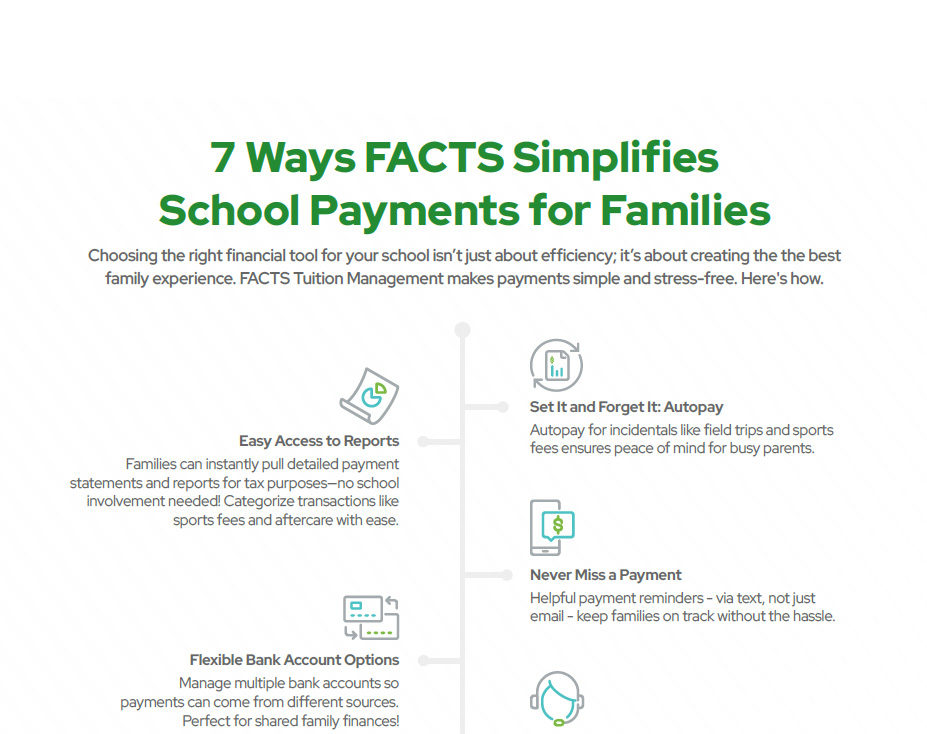
A great payment software doesn’t just make life easier for schools—it supports families, too. FACTS Tuition Management is designed to simplify financial planning for families with features like simple reporting, autopay, and text reminders. These tools help families stay on top of tuition payments effortlessly while empowering schools to operate more efficiently. Want to learn more about how FACTS Tuition Management benefits families? Download our infographic for a quick, insightful overview!
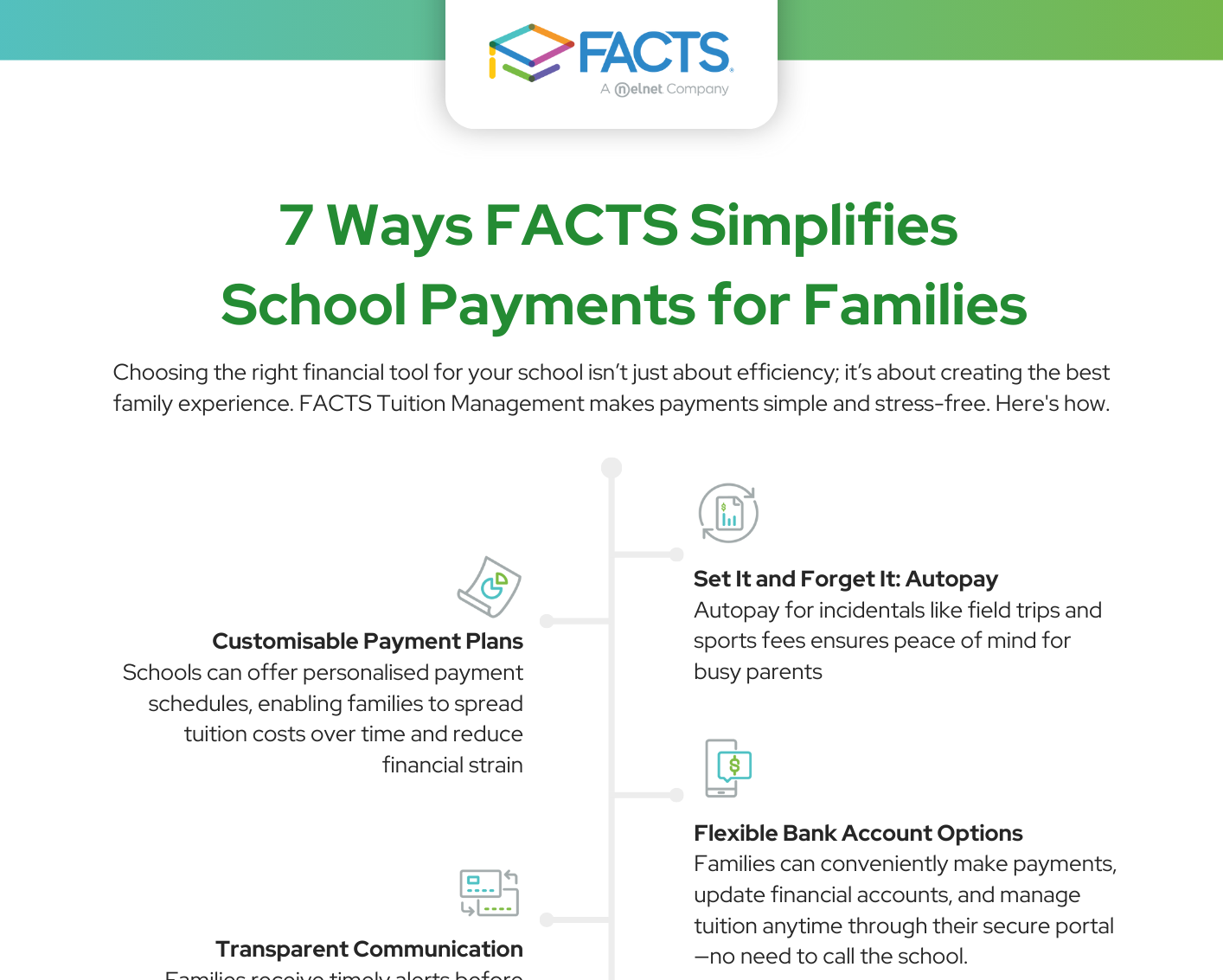
A great payment software doesn’t just make life easier for schools—it supports families, too. FACTS Tuition Management is designed to simplify financial planning for families with features like simple reporting, and autopay. These tools help families stay on top of tuition payments effortlessly while empowering schools to operate more efficiently. Want to learn more about how FACTS Tuition Management benefits families? Download our infographic for a quick, insightful overview!
Sorry, but this content is not available in your region.
Consultation is a vital opportunity for private schools to collaborate with their Local Education Agencies (LEAs) to ensure equitable access to federal funds under the Elementary and Secondary Education Act (ESEA). For your students and teachers to benefit from these resources, it’s important to understand the timeline, process, and your role in advocating for their needs.
Timely and Ongoing Consultation
The consultation process must be timely, meaningful, and ongoing by law. While discussions may happen throughout the year, late winter to early spring is a key time to watch for your LEA’s outreach. This is when LEAs will likely send Intent to Participate forms to private schools. Responding promptly to this form is critical, as it determines your eligibility to access services for the next school year.
Why Every School Should Check “Yes”
We strongly encourage every private school to check “Yes” on their Intent to Participate form. Here’s why:
- These Are Your Students’ Funds: Federal funding, including Title I and Title II allocations, is intended to support your students’ academic needs and your teachers’ professional needs.
- Equity and Opportunity: Participating ensures your students and teachers receive the resources they are entitled to, leveling the playing field for their success.
- Flexibility in Use: Responding “Yes” does not commit your school to a pre-defined program. It opens the door for meaningful discussions with your LEA about tailoring services to meet your school’s unique needs.
- Maintain School Autonomy: Checking “Yes” also ensures access to essential services while maintaining your school’s autonomy. It does not mean you’re relinquishing control or inviting unwarranted government interference into your school’s operations or decision-making.
Set Up a Planning Meeting
Once you’ve confirmed your intent to participate, the next step is to schedule a planning meeting with your LEA. This meeting is a crucial step in the consultation process, ensuring that your school is fully prepared to maximize the benefits of federal funding. Here’s what to expect and prepare for:
- Consultation With Your LEA: The LEA will usually contact your school to schedule this meeting. During the consultation, they will explain the program specifics, ensuring your school understands the expectations, obligations, and opportunities associated with federal funding.
- Program Planning: Collaborate with the LEA to develop a detailed plan outlining how the federal funds will address the specific needs of your students and teachers. During this discussion, you can also request to use a trusted third-party provider, like FACTS, to implement programs, ensuring the services are tailored to your school’s unique needs and requests.
- Data Collection and Reporting: Be prepared to provide data on student demographics, academic performance, and other relevant metrics. This information will help demonstrate your school’s eligibility and track the progress of the funded programs.
- Compliance Requirements: The LEA will review federal compliance regulations with your school. This includes ensuring that appropriate procedures are in place to meet the funding program requirements.
- Establish Clear Goals: Work together to set measurable objectives for the program’s outcomes, such as improving academic performance, offering targeted interventions, or enhancing teacher professional development.
- Clarify Roles and Responsibilities: Define the roles of your school and the LEA in implementing and managing the program. This ensures accountability and smooth coordination.
Looking Ahead
Participation in the consultation process is your chance to advocate for the resources your students and teachers need to succeed. By responding promptly, preparing thoroughly, and engaging actively with your LEA, you can ensure that federal funds are used effectively to support your school community.
FACTS Is Here to Help
At FACTS, we understand that navigating the consultation process can be complex. Our team is here to provide guidance, support, and tools to help your school make the most of the opportunities available. To make it even easier, we’re offering a free consultation checklist designed to help private schools prepare and stay organized throughout the process. Don’t leave funding on the table—take the first step by saying “Yes” and partnering with us to plan for a successful school year ahead.
Contact us today to learn more about how we can assist your school during consultation season.
Keeping your team informed about compliance and adapting to evolving regulations are essential for any manufacturing organization. According to Thomson Reuters’ 2023 Risk & Compliance Survey Report, staying on top of upcoming regulatory and legislative changes is a top strategic priority for many organizations. Navigating these changes effectively not only ensures compliance but also helps your team build and retain the skills they need to stay safe and productive.
By leveraging technology-driven compliance tools, manufacturing teams can reduce risks, eliminate inefficiencies caused by outdated processes, and streamline training efforts. Let’s explore how compliance and skill-building work together to benefit your workforce.
Why Compliance and Skill-Building Go Hand-in-Hand
Modern compliance training isn’t just about meeting regulations—it’s also an opportunity to enhance workforce skills. Keeping necessary certifications and following safety requirements requires a system that is efficient, organized, and easily accessible for frequent updates.
Compliance training does more than ensure your team is following the rules. Provide more efficient ways for your team members to complete their work, enhance safety practices, and foster collaboration for a safer, more compliant workplace.
By leveraging an integrated technological solution, you can combine compliance and comprehensive training into one platform. Offer training that teaches your team policies such as the ISO 9001 while training them on your products and best practices for managing them.
Benefits of Modernizing Compliance Training
Adopting a modern, technology-driven approach to compliance training offers numerous benefits, from boosting team efficiency to streamlining processes for added convenience. Here are three key advantages of modern compliance training technology:
- Increased Efficiency: Make it simple for your employees to learn, train, and get their necessary certifications, keeping your whole team current and compliant in less time.
- Improved Accuracy: Minimize reporting errors and simplify compliance training with all the right tools in one place.
- Audit Preparedness: Stay ready for regulatory reviews with reliable and up to date data.
Make managing compliance at your company easier, more efficient, and more effective by implementing a solution that tackles all your challenges in one system and create an environment that is safer and better managed for the benefit of your team.
How FACTS Learning can Support Your Manufacturing Team
FACTS Learning Platform is designed to simplify compliance processes while empowering HR and compliance managers to focus more on building your team’s workplace skills. Experience key features such as:
- Automated Compliance Tracking: Eliminate the need for manual spreadsheets and paperwork. With automated tracking, you can ensure consistent monitoring of compliance requirements while reducing the risk of human errors. Make it simple for your employees to learn, train, and get their necessary certifications, keeping your whole team current and compliant in less time.
- Safety Certification Management: Keeping employee certifications current is critical. The FACTS platform makes it easy to manage certifications, send reminders, and ensure compliance deadlines are met.
- Real-Time Reporting: Instantly access accurate data to stay prepared for audits and make informed decisions. Real-time insights help you track progress and identify gaps in compliance or training efforts.
With FACTS Learning Platform, you can not only streamline administrative tasks but also ensure your workforce remains audit-ready and equipped with the skills you need to thrive.
Ready to simplify compliance and build workforce skills? Discover how the FACTS Learning Platform can transform your team’s compliance training today.
Parents value flexibility and convenience when it comes to paying for their student’s tuition. By offering payment plans at your school with tools like FACTS Tuition Management, you can simplify tuition payments for current families and stand out to new families looking for the right school for their student.
But how? Here are some ways implementing an efficient tuition management system can elevate your school’s marketing and bring in new families while remaining effective and efficient for your school staff.
Offer an All-in-One Experience
Your families are busy. Make it simple for families to manage their tuition finances with a tuition payment solution where they only need one login to access both student information and financial details, showing your school’s commitment to convenience and efficiency. Families can handle everything from tuition payments to extracurricular fees all in one place and on their own time, maximizing convenience for them and reducing time spent by your administrative staff answering their questions.
Reduce Enrollment Barriers with Comprehensive Options
Integrating tuition contracts and payment plans into your enrollment process eliminates friction and makes it easier for families to commit to joining your school community. Give parents the option to pay for their student’s tuition over a longer period rather than all up front, giving them more room to breathe and peace of mind. Offering these plans alongside features like incidental billing and prepay accounts also reduces enrollment barriers for prospective families, positioning your school as flexible and accommodating to families with various needs.
Let Your Team Focus on What Matters
Leverage easy-to-use dashboards and make it simple to stay on top of payments, allowing for better budgeting and improved cash flow that can be invested back into the school. Automated payment processing and advanced accounting features also free up your administrative team to focus on building relationships with families and students.
Strengthen Family Relationships
Reduce misunderstandings and foster trust with transparent, consistent communications regarding tuition and fees between your school and families. Clearly outlined enrollment contracts and tuition agreements set shared expectations from the start, minimizing confusion and building confidence in your school’s processes. Offer flexible payment options within these agreements to reflect your school’s commitment to understanding and supporting diverse financial situations. When families feel informed, respected, and supported, they’re more likely to stay engaged—helping improve student retention and reinforce the strong, lasting connections your school community is known for.
Offering tuition payment options that are flexible and affordable can be a crucial part of making your school the right choice for more families. Learn more about FACTS Tuition Management to see how.
The role of the school business manager has always been diverse and demanding. Covering a wide range of functions and dealing with many stakeholder groups, school business managers wear many hats – and the demands on them are growing as the education sector evolves.
In a day, a business manager may find themselves reconciling accounts, dealing with staff issues, negotiating supplier contracts, acting on behalf of the principal, arranging a board meeting, supporting the fundraising committee, and more. For this reason, they must have skills in a range of areas including finance, management, project management, and compliance.
Equally important is that they’re supported by a comprehensive and intuitive payment platform that allows them to manage payments flexibly, securely, and efficiently. Purpose-built school payment software like FACTS enables schools to simplify and streamline their approach to payments, providing more control, visibility, and convenience to both administrators and families.
Integrated tuition management
Managing tuition payments effectively is a key challenge for schools. Many still take a manual approach which is time-consuming and inefficient.
Schools without a flexible, centralised payment system will often have teams of staff who take many weeks to coordinate the payment process at the start of each school year. Managing year level or subject-specific pricing, discounts, and any credits or debits to be applied to an account becomes labour intensive and error-prone. Additionally, neither the school nor families have visibility of their financial position.
FACTS supports K-12 schools to deliver a better payment experience for families while reducing the workload of their administrative team. Our world-class billing engine gives both user groups real-time visibility of payments made, scheduled and missed, 24/7, wherever they are.
Smart online forms
Paper-based forms and payment slips are unpopular with administrators and families alike. Easy to forget or misplace, it’s inconvenient for families to manually record information the school already holds about them – and collecting payment information on paper forms is not PCI DSS (Payment Card Industry Data Security Standard) compliant.
FACTS’ flexible online forms allow simple and efficient management of permission and payment for extras like school excursions and trips. FACTS forms collect information via a secure and encrypted platform, with any costs automatically added to each family’s account, so no cash or manual payments are needed. It’s a more flexible, convenient, cost-effective, and secure way for schools to manage permissions and payments required throughout the year.
Complete cash flow management and real-time reporting
Many schools without a comprehensive payment system lack a strong understanding of their current financial position. Managing tuition fees, fundraising efforts, and incidental expenses in separate spreadsheets can make it impossible to get an accurate real-time view of a school’s financial health.
School payment software allows administrators to view key financial metrics at a glance. Business managers can build customised reports and schedule these to be created and shared with key stakeholders on a daily, weekly, or monthly basis. Powerful analytics let the administration team identify and manage arrears, hardship, and other financial aspects with confidence the latest information is at their fingertips.
Best-in-class data security
Keeping personal and payment information safe is imperative for all schools. The traditional approach of sending forms home in schoolbags to be completed and returned presents many opportunities for this confidential information to be lost.
Tools like FACTS allow schools to collect and store this information securely and give families the opportunity to update their information at their convenience via a secure online portal, 24/7. This means no need for the school administration team to chase forms and payments or enter data manually. It’s also more efficient for families, who won’t be asked to provide the same information each time there’s a camp or excursion.
FACTS is PCI level 1 compliant, the highest level of validation given by the Payment Card Industry Data Security Standards (PCI DSS).
FACTS supports a seamless flow of information between a school’s administration team and its teachers, students, and families. From enrolment to graduation, it allows information to be captured and stored securely – meaning no manual data entry for schools, and no need for families to provide the same information time and time again.
A complete school payment platform supports business managers to meet the competing aspects of their role with agility, and give families and the administration team better flexibility, control, and visibility.
School management platforms exist to streamline school operations and automate time-consuming administrative tasks and processes. However, today’s best school management platforms (SMPs) deliver benefits beyond a school’s business office, revolutionising how teachers perform their roles too. Quality SMPs support classroom teachers to simplify the way they plan, deliver and assess learning, track attendance, communicate with students and families, and more. By streamlining or eliminating various daily processes, student management software empowers teachers to spend less time on administration and more time on teaching and learning activities.
In this blog, we share six ways school management platforms can improve teachers’ productivity and performance.
1. Lesson planning
SMPs allow teachers to plan lessons and collaborate in year-level or subject-area groups to build and deliver a curriculum that’s engaging and consistent. Working digitally, teachers can lesson plan at school or remotely, add resources that align with the subject matter, and stay on top of the homework that’s been assigned. A digital approach also allows substitute teachers to step into a classroom with confidence that all the information they need to deliver the day’s learning is at their fingertips.
2. Managing attendance
Most schools now record attendance digitally. However, attendance data can be fractured, incomplete and unreliable without an integrated school-wide approach. Modern SMPs let classroom teachers record, monitor and report on attendance with consistency and confidence, while automatically notifying families if a student is late or absent. They make it easy to stay on top of planned absences and offer sophisticated reporting and analytics that highlight any emerging trends.
3. Assessment and reporting
Student assessment is a notoriously time-consuming teacher task. A quality SMP removes much of the administrative burden of assessment and reporting by providing tools that streamline the report writing process. Functionality like test importing, editable comment banks, and integration with state and national standards empowers teachers to create student reports accurately and efficiently.
4. Monitoring behaviour and wellbeing
Schools are increasingly focused on student wellbeing as a critical component of their school experience. A good SMP will allow teachers to edit and view important behavioural and wellbeing information, including any interventions in place to support an individual student’s wellbeing.
5. Communicating with families
An SMP provides an invaluable communication bridge between teachers, students and families. Most platforms offer multi-channel options including email, SMS and app. Teachers value the opportunity to contact families privately without providing their personal phone numbers and the flexibility to send bulk or individual messages. Chasing consent or payment digitally is much more efficient than trying to catch parents at drop-off or calling each relevant family individually.
6. Booking resources
Getting access to shared school resources when they need them is central to a teacher’s ability to deliver their lesson plan. Whether teachers need to use the gym or art room, sports gear or IT equipment, their ability to see and book available resources – both in advance and in real time – via an SMP is invaluable.
School management software can be used in various ways within the classroom to help teachers maximise the time they have for learning delivery. With everyday tasks executed quickly and accurately and automated where possible, improved teacher productivity can in turn have a meaningful impact on student learning and performance.
FACTS School Management’s comprehensive suite of school and financial management tools empowers K-12 schools to operate more efficiently and effectively in all areas. Trusted by more than 11,500 K-12 schools across the globe, FACTS empowers administrators and classroom teachers to spend less time on routine tasks and more time delivering high-quality learning.
Sending your child to school can be a significant investment. While school tuition fees vary considerably across Australia, the average total cost of education for a child starting at an independent school could be more than $340,000.
For families that choose private schooling, tuition fees are likely to be a large portion of their household budget. For this reason, the way your school manages tuition fees is likely to be a key decision factor for many families.
Schools generally put a lot of time and effort into ensuring their word-of-mouth, website, social media channels, and presence on review sites such as the Good Schools Guide position them as an attractive choice for potential students. However, once families have narrowed their choices down to their top two or three schools, aspects like the ease of the enrolment process and a flexible approach to tuition fees can be critical differentiators.
So, is the way your school manages tuition fees part of your marketing arsenal? Here’s how to highlight payment plans in your school’s marketing efforts and give families confidence that you’re there for them if times get tough.
Take a Flexible Approach to Tuition Fees
Publicise that you provide flexible payment options and due dates. Rather than expecting the year’s tuition up front, consider offering weekly, bi-weekly, quarterly, monthly or term-based payment plans. You should also let families choose from a selection of regular due dates so that they can pick one that reflects their payroll schedules.
Give families the flexibility to get ahead on tuition payments by allowing them to make online payments ahead of the due date. When you give families options, they’ll feel more confident that they can afford to send their child to your school.
Specialist tuition payment solutions like FACTS allow you to provide this level of flexibility without creating reconciliation nightmares. FACTS lets you simplify fee tracking and management and gives you real-time visibility of payments and cash flow projections.
Add Fee Information to Your School’s Website
When families contact your school to request a tour, it’s fair to assume that they’ve done their research and know about your school’s ethos, how your results rank against other local schools, and how much it costs to attend.
Be transparent about tuition fees on your school’s website and include information about families’ options when paying fees and applying for financial aid. Tuition fees will be one of the first aspects families consider when researching and comparing schools, so you should make it easy for them to find this information and give them comfort that you offer affordable and flexible payment plans.
Make Fee Affordability an Ongoing Conversation
Fee affordability can be a challenge for families throughout their time with your school, not just at enrolment. Don’t let financial constraints become a reason students leave. Check in with families each year or semester to ensure they’re comfortable with their payment plan and know that there’s a range of payment options available to them.
Offering flexible tuition payment plans is a great way to attract new students and support existing families. It does more than give families another payment option – it builds your reputation as a school that cares and is willing to work with families to keep them enrolled.
Marketing the affordability options your school offers shows that you’re willing to let families take control of their finances and open to adapting to meet changing situations and needs. By making families’ lives easier, you can build a strong and supportive school community.

